Motorola Solutions 99FT3048 CM200/CM300 VHF Mobile Radio User Manual 96C22 O cvr
Motorola Solutions, Inc. CM200/CM300 VHF Mobile Radio 96C22 O cvr
Contents
exhibit 08b users guide cm300
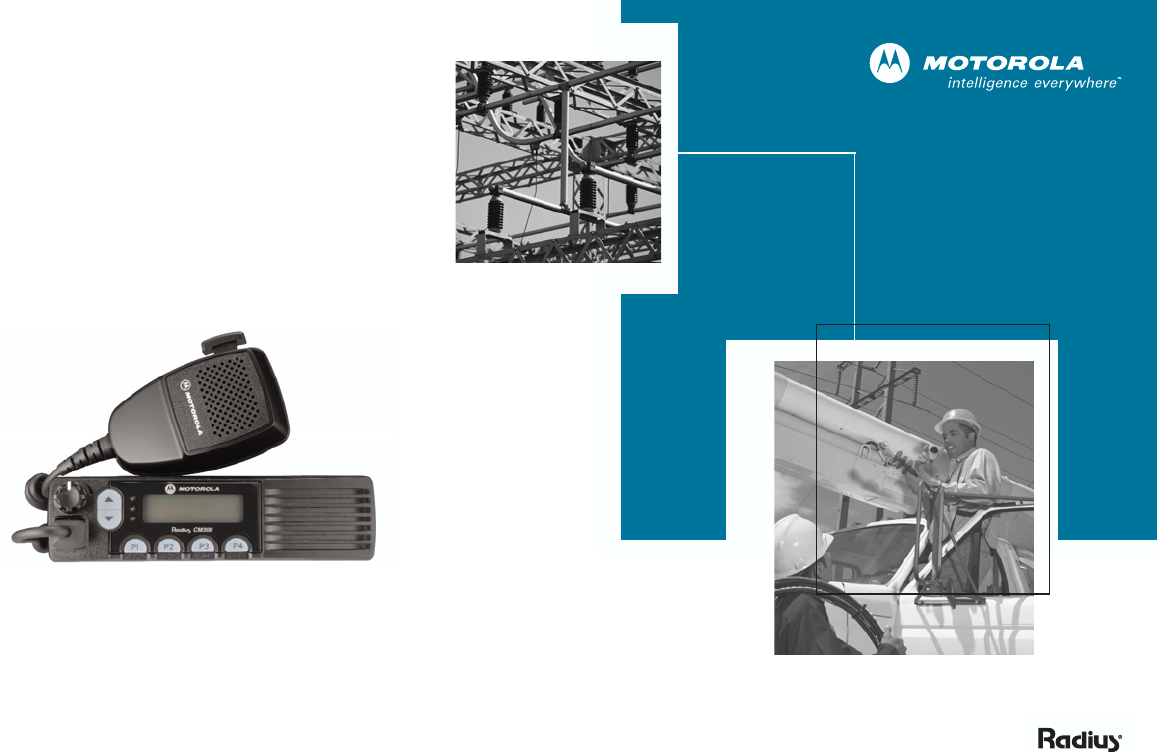
CM300™
Commercial Series
Two-Way Radio User Guide
Manuel de l'utilisateur
de la radio bidirectionnelle
MOTOROLA, the Stylized M Logo, and Radius are registered in the US Patent & Trademark Office.
All other product or service names are the property of their respective owners.
© Motorola, Inc. 2003. All rights reserved. Printed in U.S.A.
MOTOROLA, le logotype au M stylisé et Radius sont enregistrés auprès du Bureau des marques et brevets des États-Unis.
Tous les autres noms de produits et de services sont la propriété de leurs titulaires respectifs.
© Motorola, Inc. 2003. Tous droits réservés. Imprimé aux États-Unis.
*6881096C22*
68P81096C22-O
96C22-O_cvr.qxd 7/2/2003 11:04 AM Page 1
COMPUTER SOFTWARE
COPYRIGHTS
The Motorola products described in this
manual may include copyrighted Motorola
computer programs stored in semiconductor
memories or other media. Laws in the United
States and other countries preserve for
Motorola certain exclusive rights for
copyrighted computer programs including, but
not limited to, the exclusive right to copy or
reproduce in any form the copyrighted
computer program. Accordingly, any
copyrighted Motorola computer programs
contained in the Motorola products described
in this manual may not be copied, reproduced,
modified, reverse-engineered, or distributed in
any manner without the express written
permission of Motorola. Furthermore, the
purchase of Motorola products shall not be
deemed to grant either directly or by
implication, estoppel, or otherwise, any license
under the copyrights, patents or patent
applications of Motorola, except for the normal
non-exclusive license to use that arises by
operation of law in the sale of a product.
EnglishTOC.fm Page 0 Friday, July 11, 2003 11:13 AM

1
English
CONTENTS
CONTENTS
Computer Software Copyrights. . .inside cover
Safety . . . . . . . . . . . . . . . . . . . . . . . . . . . . . . 3
Product Safety and RF Exposure
Compliance . . . . . . . . . . . . . . . . . . . . . . . . . 3
Introduction . . . . . . . . . . . . . . . . . . . . . . . . . 5
Conventional Radio Systems . . . . . . . . . . . . 5
CM300 Radio Features . . . . . . . . . . . . . . . . . 5
Radio Wide Features . . . . . . . . . . . . . . . . 5
Signaling Features . . . . . . . . . . . . . . . . . . 5
Radio Overview . . . . . . . . . . . . . . . . . . . . . . 7
LED Indicators. . . . . . . . . . . . . . . . . . . . . . . . 8
Display . . . . . . . . . . . . . . . . . . . . . . . . . . . . . 8
Optional Enhanced Keypad Microphone
(RMN5029) . . . . . . . . . . . . . . . . . . . . . . . . . 9
Indicator Tones . . . . . . . . . . . . . . . . . . . . . . 11
Programmable Buttons . . . . . . . . . . . . . . . . 12
Menu Buttons . . . . . . . . . . . . . . . . . . . . . . . 15
Menu Button. . . . . . . . . . . . . . . . . . . . . . 15
Menu Scroll Buttons. . . . . . . . . . . . . . . . 15
Navigate the Menu. . . . . . . . . . . . . . . . . 15
Getting Started . . . . . . . . . . . . . . . . . . . . . .17
Turn the Radio On or Off . . . . . . . . . . . . . . .17
Adjust the Volume . . . . . . . . . . . . . . . . . . . .17
Select a Radio Channel . . . . . . . . . . . . . . . .17
Receive. . . . . . . . . . . . . . . . . . . . . . . . . . . . .18
Monitor . . . . . . . . . . . . . . . . . . . . . . . . . . . . .18
Silent Monitor. . . . . . . . . . . . . . . . . . . . . .18
Open Squelch Monitor. . . . . . . . . . . . . . .18
Transmit . . . . . . . . . . . . . . . . . . . . . . . . . . . .19
Repeater or Talkaround Mode . . . . . . . . . . .19
Home Revert Memory Channel (1 & 2) . . . .20
Store Memory Channel (1 & 2). . . . . . . . . . .20
Set Local or Distance Mode . . . . . . . . . . . . .20
VOX Operation . . . . . . . . . . . . . . . . . . . . . . .21
Program PL/DPL Codes . . . . . . . . . . . . . . . .21
Radio Calls . . . . . . . . . . . . . . . . . . . . . . . . .23
Selective Radio Inhibit . . . . . . . . . . . . . . . . .23
Receive a Selective Call. . . . . . . . . . . . . . . .23
Send a Selective Call . . . . . . . . . . . . . . . . . .23
Receive a Call Alert™ Page . . . . . . . . . . . . .24
Send a Call Alert Page . . . . . . . . . . . . . . . . .24
Repeater Access . . . . . . . . . . . . . . . . . . . . .25
Emergency Alerts . . . . . . . . . . . . . . . . . . . . .26
Send an Emergency Alert. . . . . . . . . . . . . . .26
Clear an Emergency Alert . . . . . . . . . . . . . .26
EnglishTOC.fm Page 1 Friday, July 11, 2003 11:13 AM

2
English
CONTENTS
Scan . . . . . . . . . . . . . . . . . . . . . . . . . . . . . . .27
Talkback . . . . . . . . . . . . . . . . . . . . . . . . . . . .27
Start System Scan . . . . . . . . . . . . . . . . . . . .27
Stop System Scan . . . . . . . . . . . . . . . . . . . .28
Start Auto Scan . . . . . . . . . . . . . . . . . . . . . .28
Stop Auto Scan. . . . . . . . . . . . . . . . . . . . . . .28
Delete a Nuisance Channel . . . . . . . . . . . . .29
Restore Channels to the Scan List . . . . .29
Edit a Scan List. . . . . . . . . . . . . . . . . . . . . . .29
Add or Delete Channels in a Scan List. . . . .30
Prioritize a Channel in a Scan List . . . . . . . .31
Phone. . . . . . . . . . . . . . . . . . . . . . . . . . . . . .33
Receive a Phone Call . . . . . . . . . . . . . . . . . .33
Make a Phone Call . . . . . . . . . . . . . . . . . . . .34
Edit the Phone List . . . . . . . . . . . . . . . . . . . .36
Add an Entry . . . . . . . . . . . . . . . . . . . . . .36
Delete an Entry . . . . . . . . . . . . . . . . . . . .37
Edit an Entry . . . . . . . . . . . . . . . . . . . . . .38
Edit Access/Deaccess Codes . . . . . . . . .39
Tone Preferences . . . . . . . . . . . . . . . . . . . .41
Tones On/Off . . . . . . . . . . . . . . . . . . . . . . . .43
Keypad On/Off Tones. . . . . . . . . . . . . . . . . .43
Call Tone Tagging . . . . . . . . . . . . . . . . . . . .44
Escalert. . . . . . . . . . . . . . . . . . . . . . . . . . . . .44
User Settings . . . . . . . . . . . . . . . . . . . . . . . 47
Set Squelch Level . . . . . . . . . . . . . . . . . . . . 49
Set Power Level. . . . . . . . . . . . . . . . . . . . . . 49
Option Board On/Off . . . . . . . . . . . . . . . . . . 50
Set the Backlight Intensity . . . . . . . . . . . . . . 50
Display the Software Version. . . . . . . . . . . . 51
Warranty . . . . . . . . . . . . . . . . . . . . . . . . . . . 53
Limited Warranty . . . . . . . . . . . . . . . . . . . . . 53
Accessories . . . . . . . . . . . . . . . . . . . . . . . . 57
Antennas . . . . . . . . . . . . . . . . . . . . . . . . . . . 57
Alarm and Accessories . . . . . . . . . . . . . . . . 57
Audio . . . . . . . . . . . . . . . . . . . . . . . . . . . . . . 57
Cables . . . . . . . . . . . . . . . . . . . . . . . . . . . . . 58
Control Station . . . . . . . . . . . . . . . . . . . . . . . 58
Data - CES Wireless Technologies . . . . . . . 58
Mounting . . . . . . . . . . . . . . . . . . . . . . . . . . . 59
Public Address . . . . . . . . . . . . . . . . . . . . . . . 59
Peripherals. . . . . . . . . . . . . . . . . . . . . . . . . . 59
EnglishTOC.fm Page 2 Friday, July 11, 2003 11:13 AM

3
English
SAFETY
SAFETY
PRODUCT SAFETY AND RF
EXPOSURE COMPLIANCE
ATTENTION!
This radio is restricted to occupational use
only to satisfy FCC RF energy exposure
requirements. Before using this product, read
the RF energy awareness information and
operating instructions in the Product Safety
and RF Exposure booklet enclosed with your
radio (Motorola Publication part number
68P81095C99) to ensure compliance with RF
energy exposure limits.
For a list of Motorola-approved antennas,
batteries, and other accessories, visit the
following web site which lists approved
accessories: http://www.motorola.com/cgiss/
index.shtml.
Before using this product, read
the operating instructions for safe
usage contained in the Product
Safety and RF Exposure booklet
enclosed with your radio.
!
C a u t i o n
00_SafetyNA.fm Page 3 Friday, July 11, 2003 11:11 AM

4
English
SAFETY
Notes:
00_SafetyNA.fm Page 4 Friday, July 11, 2003 11:11 AM

5
English
INTRODUCTION
INTRODUCTION
CONVENTIONAL RADIO SYSTEMS
Conventional radio systems typically refer to
unit-to-unit communications through a single
channel. Conventional systems also allow
radio users to extend communication coverage
by relaying their messages through a repeater.
To ensure coordinated use by multiple users,
each radio user must monitor the channel or
repeater before transmitting to verify that the
system is not currently busy.
CM300 RADIO FEATURES
Radio Wide Features
• 32 Channels
• 8-Character Alphanumeric Display
• 4 Programmable Feature Buttons
• 2 Memory Channels
• Telephone Interconnect
• User-programmable Phone, Scan Lists,
TPL/DPL
• Option Board Expandability
– Secure Voice/Scrambling
– SmarTrunk II
– DTMF Decode
• Busy Channel Lockout
• High/Low Power Settings
• Local/Distance Mode
• Time-Out Timer
• Monitor and Sticky Permanent Monitor
• System Scan with 2 Priority Levels and
Revert Scan
Signaling Features
• MDC 1200 Signaling
• Quik-Call II Signaling
-Emergency
Alert
- Selective Radio
Inhibit
- PTT ID Encode/
Decode
- Call Alert
- Selective Call - Radio Call List
- Call Tone Tag-
ging
00_Introduction.fm Page 5 Friday, July 11, 2003 11:11 AM

6
English
INTRODUCTION
• DTMF Signaling
- DTMF PTT ID
Encode/Decode
- DTMF Call Alert
-DTMF
Selective Call
00_Introduction.fm Page 6 Friday, July 11, 2003 11:11 AM
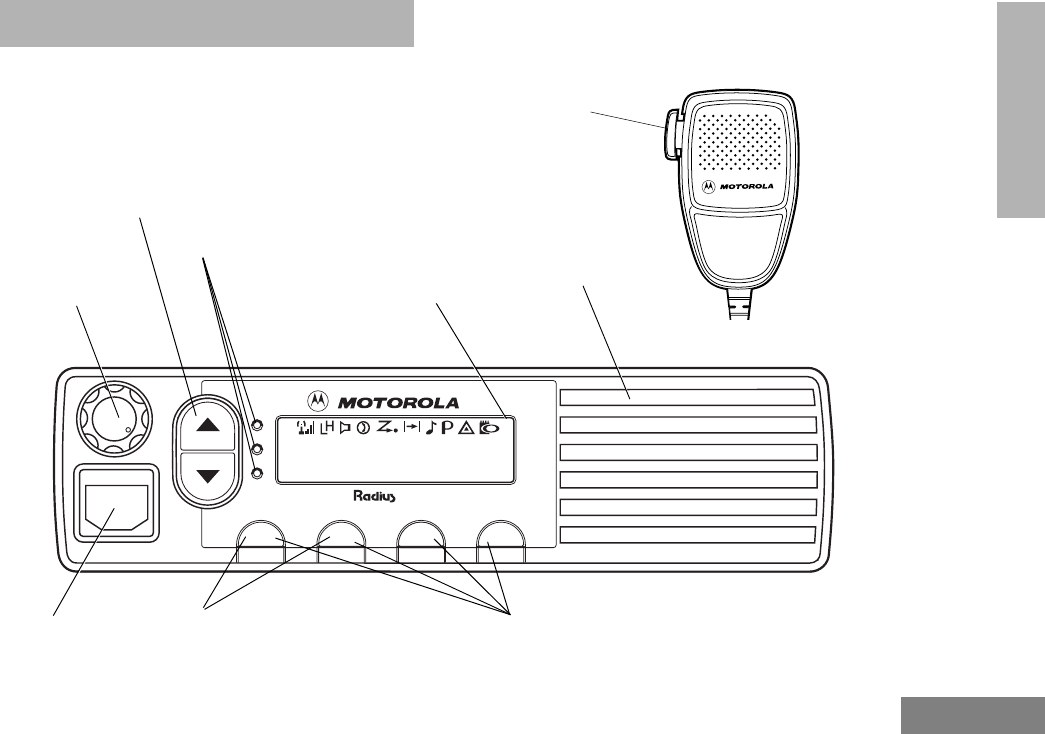
7
English
RADIO OVERVIEW
RADIO OVERVIEW
P2
P1 P3 P4
CM300
PERS4
Red/Yellow/Green
LED Indicators
(P1, P2, P3, P4)
Microphone
Jack
Knob
On/Off/Volume
Programmable Buttons
Display
Channel Selector/
Push-To-Talk
(PTT) Button
Speaker
Menu Scroll Buttons
Menu Buttons
(P1, P2)
01_Overview.fm Page 7 Friday, July 11, 2003 11:27 AM
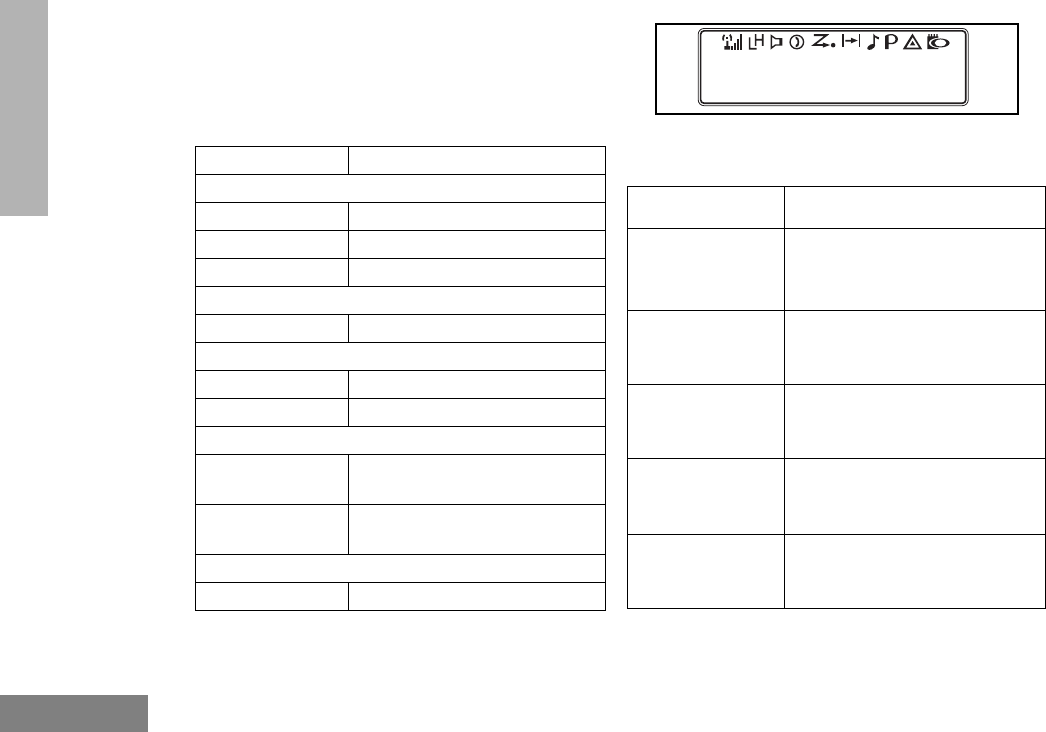
8
English
RADIO OVERVIEW
LED INDICATORS
Indicates power up, transmit, receive, scan,
monitor status, channel busy, Call Alert™
receive/transmit, and Selective Call receive/
transmit.
DISPLAY
The top row displays menu and radio status
information:
LED State/Color Indication
Radio Call
Red Transmitting
Flashing Red Receiving
Flashing Red Channel Busy
Scan
Flashing Green Scanning for activity
Call Alert
Flashing Yellow Indicates receiving a Call Alert
Yellow Indicates sending a Call Alert
Selective Call
Flashing Yellow Indicates receiving a Selective
Call
Yellow Indicates sending a Selective
Call
Sticky Monitor/Open Squelch
Yellow While monitoring
Symbol Indication
I
Signal Strength
The more bars, the stronger
the signal being received by
your radio.
B
Power Level
Low Power “ R” or High Power
“ S” is activated.
C
Monitor
The selected channel is being
monitored.
D
Phone
Phone mode is selected.
G
Scan
Indicates that the Scan
feature has been activated.
PERS4
01_Overview.fm Page 8 Friday, July 11, 2003 11:27 AM
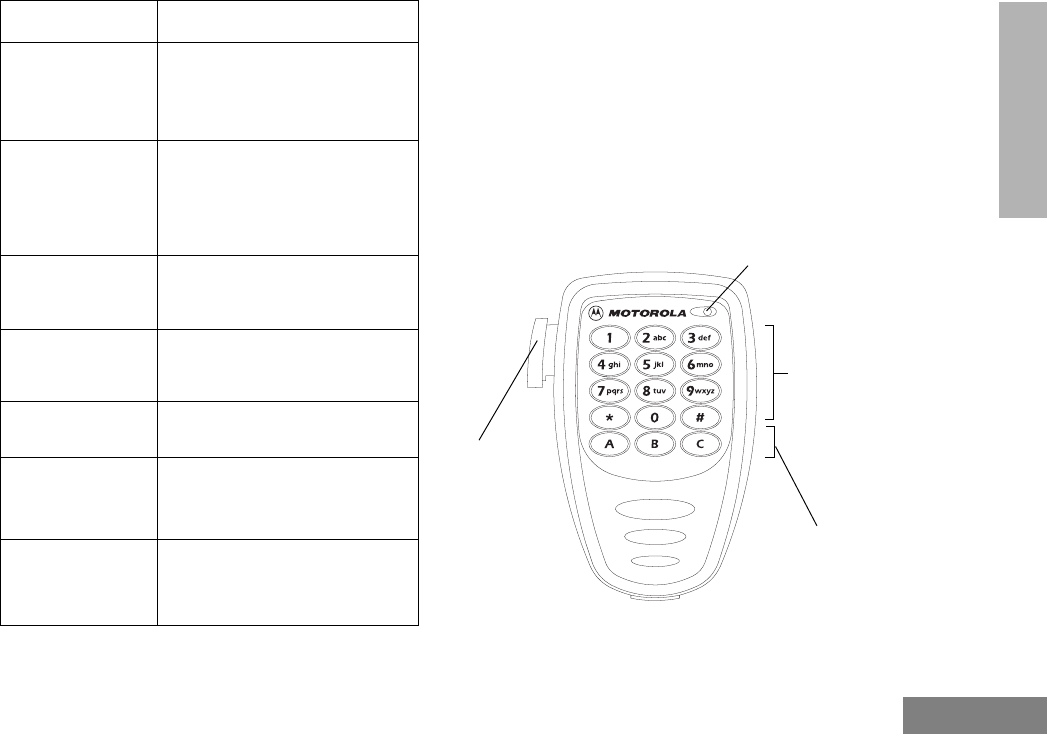
9
English
RADIO OVERVIEW
OPTIONAL ENHANCED KEYPAD
MICROPHONE (RMN5029)
Your radio may be ordered with an optional
DTMF (Dual-Tone Multi-Frequency)
microphone that has a direct entry keypad.
This keypad microphone has three
programmable buttons (A, B, C) below the
keypad that can be programmed to
conveniently activate select radio features.
H
Priority 1 Scan
( • flashing)
Indicates scan has stopped
and landed on an active
Priority 1 channel.
H
Priority 2 Scan
( • steady)
Indicates scan has stopped
and landed on an active
Priority 2 channel.
J
Talkaround
You are not transmitting
through a repeater
F
Call Received
A Selective Call or Call Alert
has been received.
BNot Used
E
Emergency
An Emergency Alarm is being
sent.
A
Option Board
An Option Board has been
activated.
Symbol Indication
DTMF
Push-to-Talk
(PTT) button
Programmable
Buttons
(A, B, C)
Microphone
Keypad
01_Overview.fm Page 9 Thursday, July 24, 2003 4:14 PM

10
English
RADIO OVERVIEW
The keypad is used for:
• Dialing a phone number.
• Entering information when programming
phone lists.
• Directly accessing preprogrammed features
(see page 13).
Each key can generate several different
characters. For example, to enter the
character “C,” press the 2 button three
times. (Refer to the Entering Characters
Using the DTMF Microphone Keypad table.)
Entering Characters Using the DTMF
Microphone Keypad
Number of Times Button is Pressed
Button 1 2 3 4 5
00
11/ \
2ABC2
3DEF3
4GH I 4
5JKL5
6MNO6
7PQRS7
8TUV8
9WX YZ9
**<>
##+ -_
01_Overview.fm Page 10 Friday, July 11, 2003 11:27 AM
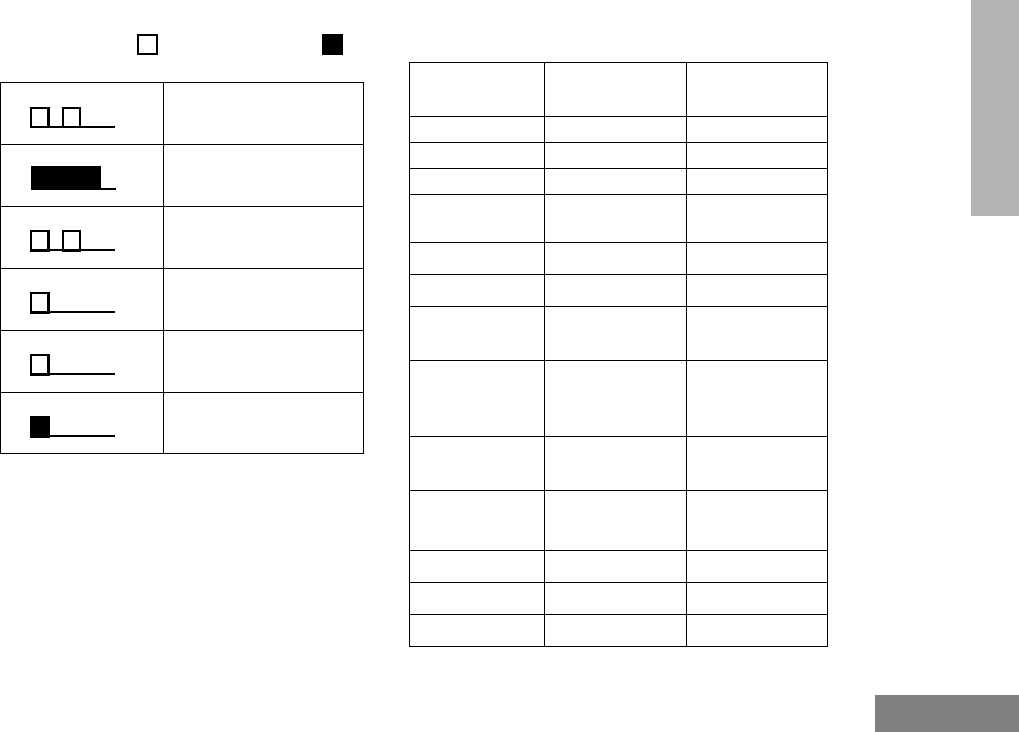
11
English
RADIO OVERVIEW
INDICATOR TONES
High pitched tone Low pitched tone
Some programmable buttons use tones to
indicate one of two modes:
Self Test Pass Tone
Self Test Fail Tone
Positive Indicator Tone
Negative Indicator Tone
Good Key Press
Bad Key Press
Programmable
Buttons Positive
Indicator Tone Negative
Indicator Tone
Scan Start Stop
Power Level High Low
Squelch Tight Normal
Repeater/
Talkaround Does not use
repeater Uses repeater
VOX Enabled Disabled
Local/Distance Local Distance
Sticky Monitor/
Open Squelch —Enabled
Home Revert
Memory
Channel (1&2)
—Enabled
Story Memory
Channel (1&2) —Stored
Menu Mode
D
—Accessed
Radio Call — Enabled
Scan List Edit — Enabled
Speed Dial — Enabled
01_Overview.fm Page 11 Friday, July 11, 2003 11:27 AM

12
English
RADIO OVERVIEW
PROGRAMMABLE BUTTONS
Your radio has four programmable buttons.
Your dealer/programmer can program these
buttons as shortcuts to various radio features.
Check with your dealer/programmer for a
complete list of functions your radio supports.
Programmable buttons include:
• The four front buttons (C, D, E, and
F).
• The three buttons (A, B, and C) of the
optional DTMF microphone.
Some buttons can access up to two features,
depending on the type of button press:
•Short Press — quickly pressing and
releasing the programmable buttons,
or
•Long Press — pressing and holding the
programmable buttons for a
preprogrammed period of time,
or
•Hold Down — pressing and holding down
the programmable buttons while checking
status or making adjustments.
The table on page 13 summarizes the
programmable features available and shows
the page number where the feature is
explained.
In the “Button” column, have your dealer/
programmer record the name of the
programmable button next to the feature that
has been programmed to it.
The dealer/programmer can use the
abbreviations (P1, P2, P3, or P4) shown in the
radio illustration on page 7.
Also, where appropriate, have your dealer/
programmer indicate whether the button press
requires a short press, a long press, or needs
to be held down.
Phone Mode — Enabled
Option Board Enabled Disabled
Escalert Enabled Disabled
Programmable
Buttons Positive
Indicator Tone Negative
Indicator Tone
01_Overview.fm Page 12 Friday, July 11, 2003 11:27 AM

13
English
RADIO OVERVIEW
Programmable Features
Function Indicator Short Press Long Press Hold Down Page Button
Menu Mode —
D button enters Menu Mode and selects
menu options. C button is automatically
re-assigned to exit Menu Mode.†—15
D
Volume Set — — —
Sounds a tone
for adjusting
your radio’s
volume level.
17
Monitor C
Toggle silent
monitor operation
(also turn off open
squelch monitor
when it has been
activated).
Turn on open
squelch monitor. —18
Repeater/
Talkaround JToggle between using a repeater or
transmitting directly to another radio.†—19
Home Revert
Memory
Channel (1&2) —Provides direct
channel access. ——20
Store Memory
Channel (1&2) ——Stores current chan-
nel. —20
Local/Distance — Toggle between local mode and distance
mode.†—20
† This function is activated by EITHER a short OR a long press, but not both.
01_Overview.fm Page 13 Friday, July 11, 2003 11:27 AM

14
English
RADIO OVERVIEW
Voice Operated
Transmission
(VOX) — Toggle VOX on and off.†—21
Radio Call — Directly access the radio call menu.†—23,
24
Scan/Nuisance
Channel Delete GToggle scan on and
off.
Delete a nuisance
channel while
scanning. —27,
29
Edit Scan List —Directly access the Scan Edit menu to add,
delete, or prioritize channels.†—29
Phone DDirectly access Phone mode.†— 33,34
Speed Dial DDirectly Access Phone mode to quickly
access phone list for speed dial.†—35
Escalert On/Off —Toggles escalert on and off.†—44
Squelch — Toggles squelch level between tight and
normal squelch.†—49
Power Level BToggle transmit power level between High
and Low.†—49
Option Board AToggle the option board on and off.†—50
† This function is activated by EITHER a short OR a long press, but not both.
Programmable Features (Continued)
Function Indicator Short Press Long Press Hold Down Page Button
01_Overview.fm Page 14 Friday, July 11, 2003 11:27 AM

15
English
RADIO OVERVIEW
MENU BUTTONS
Menu Button
If preprogrammed by your dealer/programmer,
the two front buttons (C and D) can be
used, in conjunction with other programmable
features, to access and select menu options
(D); and exit menu mode (C).
The D button can be preprogrammed by
your dealer/programmer to either a short or
long press to access the Menu Mode.
Menu Scroll Buttons
Used to scroll while in Menu Mode.
Refer to the menu navigation chart for
menu selectable features at the back of
this manual.
Navigate the Menu
G or H to scroll through the menu options. If
you scroll past the last option, the selection
wraps around and starts again.
When you reach the required option, a short
press of the D button selects that option and
enters the Sub-menu.
G or H to scroll through the sub-menu
options. Select the option with a short press of
the D button.
Exit the Menu
While in Menu Mode, the C button is
automatically assigned to completely exit the
Menu Mode by a long press or by a series of
short presses to exit from a sub-level of the
menu hierarchy.
The radio also exits the menu mode if there
has been no inputs via the navigation buttons
for the “Inactivity Time” or after a selection has
been made.
Once you have exited Menu Mode, the C
and D buttons return to normal
programmable condition.
01_Overview.fm Page 15 Friday, July 11, 2003 11:27 AM

16
English
RADIO OVERVIEW
Notes:
01_Overview.fm Page 16 Friday, July 11, 2003 11:27 AM
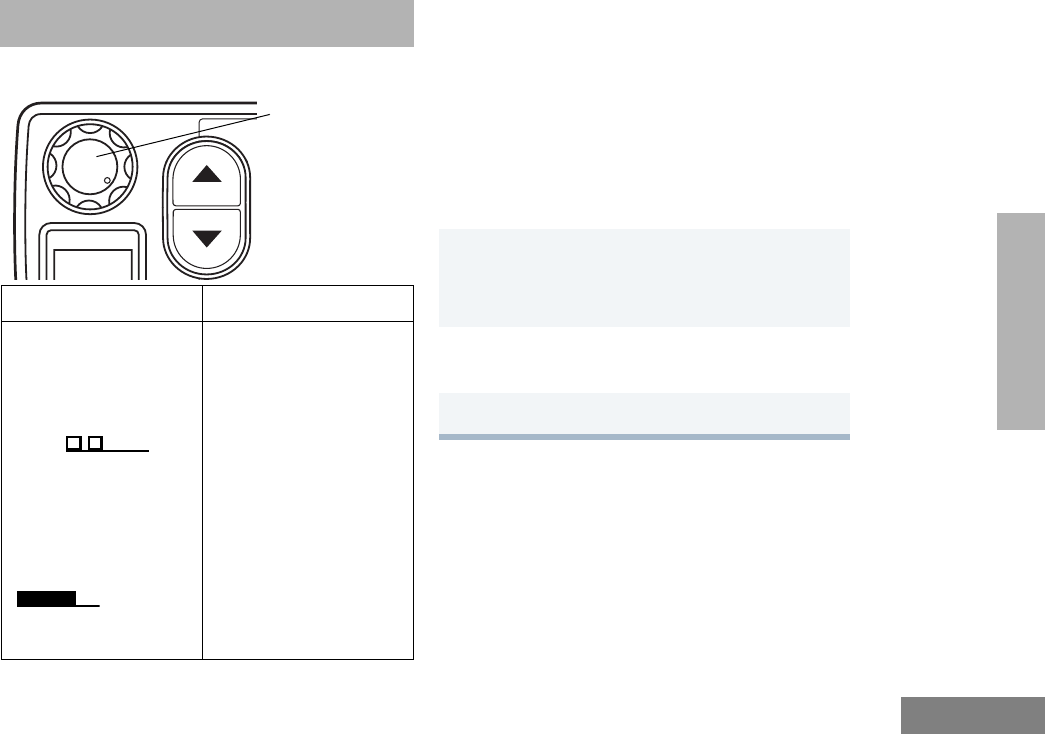
17
English
GETTING STARTED
GETTING STARTED
TURN THE RADIO ON OR OFF
ADJUST THE VOLUME
Tur n the On/Off/Volume Control knob
clockwise to increase the volume, or
counterclockwise to decrease the volume.
– or –
Note: Your dealer/programmer can
preprogram one of the programmable
buttons to Volume Set.
SELECT A RADIO CHANNEL
Up to a total of 32 channels can be
programmed into your radio.
Select a Channel
G or H to select the desired channel.
ON OFF
Rotate the On/Off/
Volume Control knob
clockwise. If power-up
is successful, you will
hear the Self-Test Pass
Tone ( ) and
see the green LED
indicator and display
icons light momentarily.
If the radio fails to
power up, you will hear
the Self Test Fail Tone
( ). The radio
will need to be returned
for re-programming.
Rotate the On/Off/
Volume Control knob
counterclockwise until
you hear a click and both
the display and LED indi-
cators turn off.
PERS
4
On/Off/Volume
Control Knob
1Hold down the Volume Set button (see
page 13).
• You will hear a continuous tone.
2Turn the On/Off/Volume Control knob to the
desired volume level.
3Release the Volume Set button.
02_GetStarted.fm Page 17 Friday, July 11, 2003 11:03 AM

18
English
GETTING STARTED
RECEIVE
MONITOR
It is important to monitor traffic before
transmitting to ensure that you do not “talk
over” someone who is already transmitting.
Silent Monitor
Open Squelch Monitor
Note: Depending on how your radio has been
programmed, per channel for transmit
and receive conditions, when the
microphone has been taken off-hook,
the radio will go into Open Squelch
mode.
1Turn your radio on.
2Adjust the radio’s volume, if necessary (see
page 17).
3G or H to select the desired channel.
• Make sure the PTT button is released.
4Listen for voice activity.
• The red LED indicator flashes while your
radio is receiving.
5To respond, hold the microphone vertically 1 to
2 inches (2.5 to 5 cm) from your mouth. Press
the PTT button to talk; release it to listen.
1A short press of the preprogrammed Monitor
button places the radio in Silent Monitor
mode.
• You hear a high-pitched tone.
2A short press of the Monitor button cancels
Silent Monitor mode and returns the radio to
normal operation.
1To place the radio in Open Squelch mode,
press and hold the preprogrammed Monitor
button until you hear a high-pitched tone.
• If no activity is present, you will hear “white
noise.”
2Momentarily press the Monitor button to
return to normal operation.
02_GetStarted.fm Page 18 Friday, July 11, 2003 11:03 AM
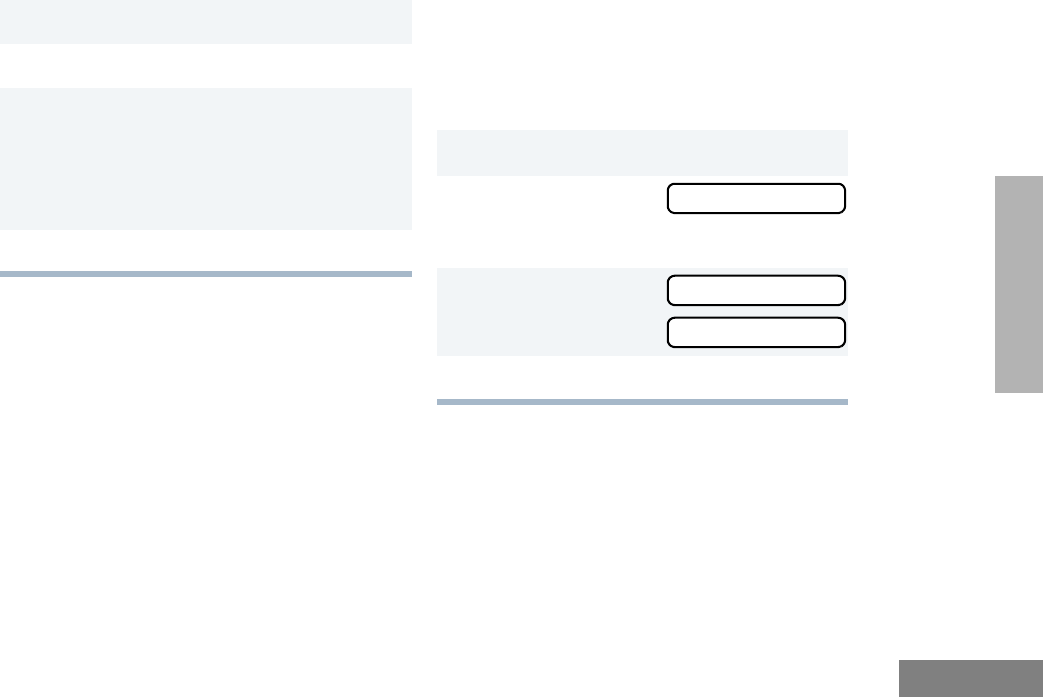
19
English
GETTING STARTED
TRANSMIT
REPEATER OR TALKAROUND J
MODE
Talkaround Mode enables you to communicate
with another radio when either:
• The repeater is not operating.
– or –
• Your radio is out of the repeater’s range but
within communicating distance of another
radio.
Note: The J symbol appears on the display
when Talkaround Mode is selected.
Select either Repeater Mode or Talkaround
Mode
Press the preprogrammed Repeater/
Talkaround button (see page 13) to toggle
between Repeater Mode and Talkaround Mode.
– or –
1Turn your radio on.
2G or H to select the desired channel.
3Hold the microphone vertically 1 to 2 inches
(2.5 to 5 cm) from your mouth. Press the PTT
button to talk.
• The red LED indicator lights steady while
the call is being sent.
4Release the PTT button to listen.
1D to enter menu mode.
2G or H until
3D to select the current setting.
4G or H until
– or – until
5D to select the current setting.
TALKARND
TALKARND
REPEATER
02_GetStarted.fm Page 19 Monday, July 14, 2003 12:45 PM

20
English
GETTING STARTED
HOME REVERT MEMORY CHANNEL
(1 & 2)
The Home Revert Memory Channel feature
allows you to instantly access up to two of your
favorite channels at the touch of a button.
To Activate Home Revert Memory Channel
Press the preprogrammed Home Revert
Memory Channel 1 button or Home Revert
Memory Channel 2 button (see page 13).
STORE MEMORY CHANNEL (1 & 2)
The Store Memory Channel (1 & 2) feature
allows you to store a channel for the Home
Revert Memory Channel feature.
G or H to select the desired channel. Press
the preprogrammed Store Memory Channel 1
button or Store Memory Channel 2 button to
store that channel (see page 13).
SET LOCAL OR DISTANCE MODE
Use this feature between Local mode (low
sensitivity) and Distance mode (normal
sensitivity). Local mode reduces interference
from other radios in close proximity. Distance
mode improves the radio’s range.
Press the preprogrammed Local/Distance
button (see page 13) to toggle between Local
and Distance mode.
02_GetStarted.fm Page 20 Friday, July 11, 2003 11:03 AM

21
English
GETTING STARTED
VOX OPERATION
When hands-free operation is desired, your
radio can transmit by voice alone using the
VOX feature when you speak through a voice
activated external microphone that is
connected to your radio.
Note: A voice activated external microphone
must be connected to your radio prior
to power-up of the radio in order to
activate the VOX feature.
To enable or disable VOX operation on a
channel, press the preprogrammed VOX
button (see page 14).
Note: Pressing the PTT button disables VOX.
– or –
You can select channels to enable or disable
VOX as preprogrammed by your dealer/
programmer.
PROGRAM PL/DPL CODES
Use this feature to edit the Private-Line/Digital
Private-Line codes for a selected channel.
1G or H to select a channel that has been
preprogrammed to enable VOX.
Note: Pressing the PTT button disables
VOX.
2G or H to select a channel that has not
been preprogrammed to disable VOX.
1D to enter menu mode.
2G or H until
3D to select
4G or H until
– or – until
5D to select the current setting.
6G or H to scroll through the standard TPL
frequencies or DPL codes.
– or –
Enter a non-standard or standard 4-digit TPL
frequency or the 3-digit octal code (numbers
0-7 only) for DPL via the DTMF microphone
keypad.
7D to confirm selection.
8C until you exit menu mode.
EDIT PL
EDIT PL
RX XXX.X
TX XXX.X
02_GetStarted.fm Page 21 Friday, July 11, 2003 11:03 AM

22
English
GETTING STARTED
Notes:
02_GetStarted.fm Page 22 Friday, July 11, 2003 11:03 AM

23
English
RADIO CALLS
RADIO CALLS
SELECTIVE RADIO INHIBIT
Your radio is equipped with a security feature
that can temporarily render the unit inoperative
when an inhibit signal is sent from the base
station.
This feature is commonly used to disable
radios:
• In case of theft
• When your vehicle is being serviced
• For system control reasons
When your radio has been rendered
inoperative by the base station, all controls will
be inoperative except for the On/Off/Volume
knob and the display shows INHIBIT.
RECEIVE A SELECTIVE CALL F
When you receive a Selective Call:
• The display shows F and the prepro-
grammed name or ID of the calling radio.
• The yellow LED indicator flashes, if pro-
grammed by your dealer/programmer.
• You hear two high-pitched tones.
SEND A SELECTIVE CALL
You can send a Selective Call to a particular
radio or to a group of radios, as programmed
by your dealer/programmer.
Press the preprogrammed Radio Call button
(see page 14), and proceed to step 4.
– or –
1To acknowledge the call, press and release the
PTT button.
2Press and hold the PTT button to talk; release
to listen.
1D to enter menu mode
03_RadioCall.fm Page 23 Friday, July 11, 2003 1:37 PM
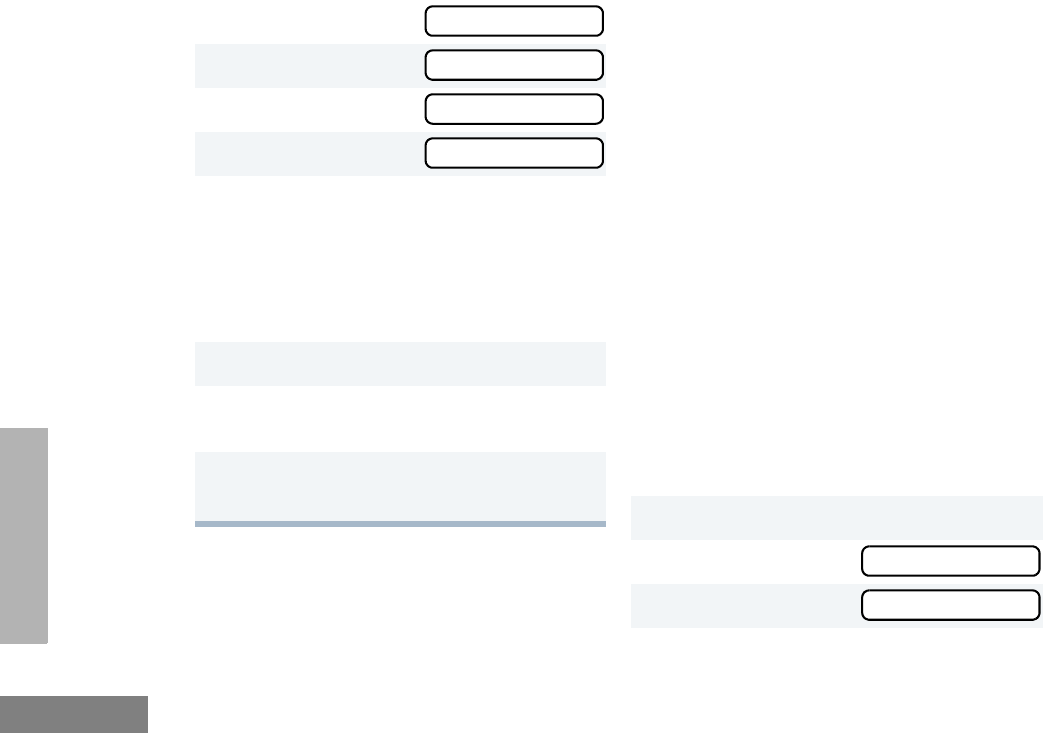
24
English
RADIO CALLS
RECEIVE A CALL ALERT™ PAGE F
When you receive a Call Alert page:
• The display shows F and the prepro-
grammed name or ID of the calling radio.
• The yellow LED indicator flashes, if pro-
grammed by your dealer/programmer.
• You hear four high-pitched tones.
To acknowledge the page, press and release
the PTT button; to cancel the page, press any
other key.
SEND A CALL ALERT PAGE
You can alert another person by sending a Call
Alert page.
Press the preprogrammed Radio Call button
(see page 14) and proceed to step 4.
– or –
2G or H until
3D to select
4G or H until
5D to select
6G or H to locate the desired ID in the
Radio Call List.
- or -
When using the enhanced keypad micro-
phone, enter a valid DTMF digit to move to
that location in the list.
7Press the PTT button to send the call.
8Press and hold the PTT button to talk; release
to listen.
9When the call is completed,
C until you exit menu mode.
RAD CALL
RAD CALL
SEL CALL
SEL CALL
1D to enter menu mode
2G or H until
3D to select
RAD CALL
RAD CALL
03_RadioCall.fm Page 24 Wednesday, August 6, 2003 2:21 PM
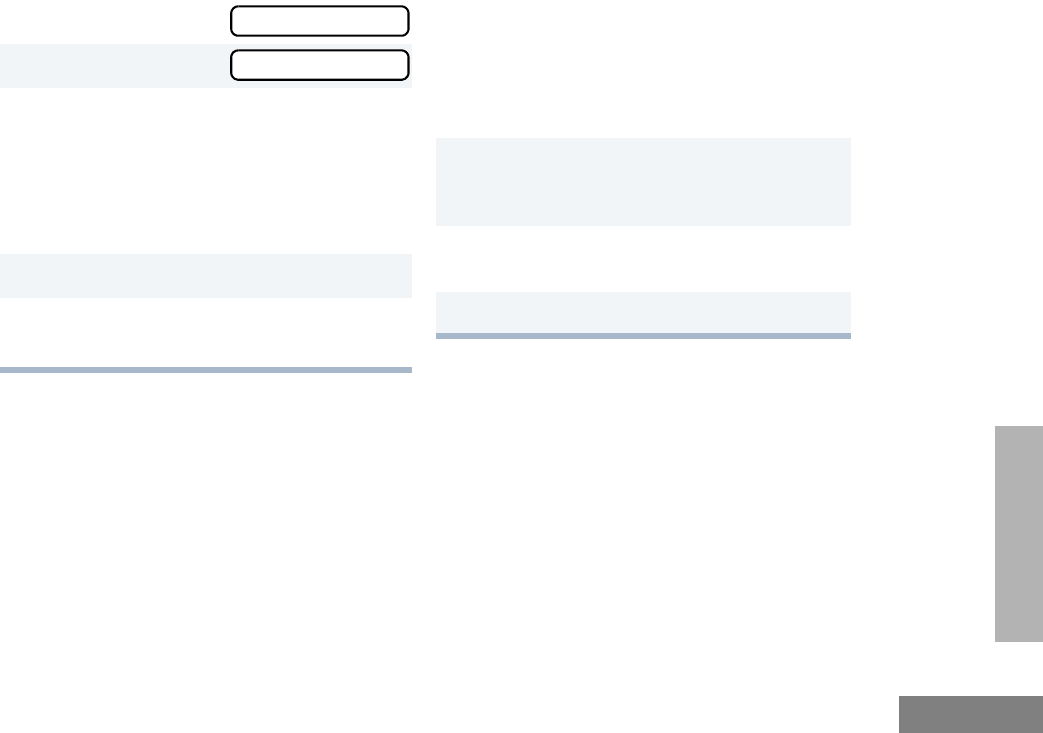
25
English
RADIO CALLS
REPEATER ACCESS
Use with Enhanced Keypad Microphone
(RMN5029)
Use this feature to send DTMF tones to a
repeater.
4G or H until
5D to select
6G or H to locate the desired ID in the
Radio Call List.
- or -
When using the enhanced keypad micro-
phone, enter a valid DTMF digit to move to
that location in the list.
7Press the PTT button to send the page.
8When the page is completed,
C until you exit menu mode.
CALL ALT
CALL ALT
1Enter your access code using the DTMF
microphone keypad and press and hold the
PTT button.
2Press and release the required DTMF
buttons.
3Release the microphone’s PTT button.
03_RadioCall.fm Page 25 Wednesday, August 6, 2003 2:21 PM

26
English
RADIO CALLS
EMERGENCY ALERTS E
Your radio offers choices for initiating and
responding to Emergency Alert
communications. An Emergency Alert can be
programmed to:
•Show E and sound a tone
–or–
• Show the normal display
–or–
• Activate the microphone so that all activity
can be transmitted (for a predetermined
amount of time). See your dealer/
programmer for more information.
Note: All choices listed are preprogrammable.
See your dealer/programmer for more
details.
• The E symbol appears on the display when
your radio is in the Emergency Alert state.
All emergency features are preprogrammed.
See your dealer/programmer for further
information on the emergency features that are
available.
SEND AN EMERGENCY ALERT E
A priority Emergency Alert can be sent to a
specific radio or dispatch center by pressing
either a foot switch or a push button accessory.
• The display shows:
Note: Emergency alerts have priority over all
other calls.
CLEAR AN EMERGENCY ALERT
An Emergency Alert can be cleared by long
pressing either a foot switch or a push button
accessory.
EMER IN
03_RadioCall.fm Page 26 Friday, July 11, 2003 1:37 PM

27
English
SCAN
SCAN
Your radio is equipped with the Scan feature,
which allows you to search for, lock onto, and
monitor voice activity on channels. Scan lists
are assigned per channel, by your dealer/
programmer. Your radio automatically switches
to a channel, within that scan list, when it
detects activity. You can also edit these lists
through your radio’s menu (see page 29).
• The green LED indicator blinks during scan
mode; it stops blinking when the radio
switches to an active channel.
•The Gsymbol appears on the display
while in scan mode.
• Your dealer/programmer can preprogram
your radio where if the microphone is taken
off-hook while in Scan mode, the scanning
activity becomes suspended until the
microphone is replaced.
There are two types of Scan available in your
radio:
•System Scan
• Auto Scan
TALKBACK
The Talkback feature allows you to respond to a
transmission while scanning. If transmission is
detected on a channel while scanning, the radio
will stop and land on that channel for a
preprogrammed period of time after activity has
ceased. This is referred to as “hangtime”.
During this hangtime you may respond by
pressing the PTT button.
Note: The LED scan indicator stops blinking
while the radio is in hangtime. If the
PTT button is not pressed after the
preprogrammed hangtime, the radio
reverts back to scan.
START SYSTEM SCAN G
Press the preprogrammed Scan button to start
System Scan (see page 14).
– or –
1G or H to select a channel that contains a
Scan list.
2D to enter menu mode.
3G or H until SYS SCAN
04_Scan.fm Page 27 Friday, July 11, 2003 11:31 AM
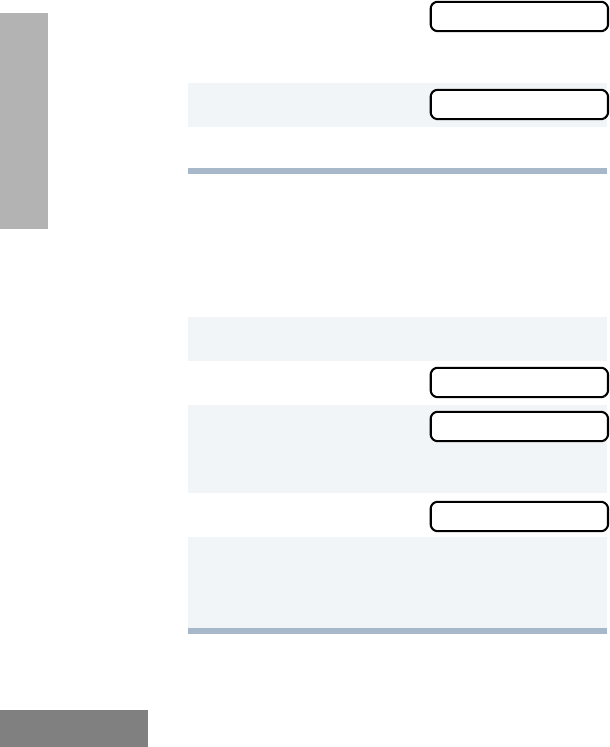
28
English
SCAN
STOP SYSTEM SCAN
Press the preprogrammed Scan button to stop
System Scan (see page 14).
– or –
Note: Your dealer/programmer can preprogram
your radio when exiting System Scan to
automatically revert to the last scan
channel that had activity on it or to
automatically revert to the channel where
scan was initiated.
START AUTO SCAN G
Auto Scan automatically starts scanning once a
channel with Auto Scan enabled is selected.
G or H to select a channel that has been
preprogrammed for Auto Scan by your dealer/
programmer.
STOP AUTO SCAN
G or H to select a channel that has not been
preprogrammed for Auto Scan by your dealer/
programmer.
•The Gsymbol disappears from the display.
4D to select
The display shows the current scan status.
5G or H until
6D to select the current setting.
1D to enter menu mode.
2G or H until
3D to select
The display shows the current scan status.
4G or H until
5D to select the current setting.
• The Gsymbol disappears from the
display.
SYS SCAN
SCAN ON
SYS SCAN
SYS SCAN
SCAN OFF
04_Scan.fm Page 28 Thursday, July 24, 2003 4:18 PM

29
English
SCAN
DELETE A NUISANCE CHANNEL
Note: Your dealer/programmer must prepro-
gram a button to Nuisance Delete to
access this feature.
If a channel continually generates unwanted
calls or noise (a “nuisance” channel), you can
temporarily remove it from the scan list:
Note: You cannot temporarily delete the
channel that has been preprogrammed
by your dealer/programmer as your
designated scan channel, a priority
channel, or the last remaining channel
in the scan list.
Restore Channels to the Scan List
EDIT A SCAN LIST
Your radio can support up to 16 Scan lists.
Each Scan list can contain up to 16 channels.
The same channel can be included in several
Scan lists, and the same Scan list can be
assigned to several channels. Scan lists are
assigned per channel, by your dealer/
programmer. When you edit a Scan list, you
can either add, delete, or prioritize channels.
1While the radio is on the Nuisance Channel,
press the preprogrammed Nuisance Channel
Delete button until you hear a tone.
2Release the Nuisance Channel Delete
button. The nuisance channel is deleted.
1Power off the radio. Once the radio is powered
on again, the deleted nuisance channels are
restored to the scan list.
–or–
2Press the preprogrammed Scan button to stop
the scan.
3Press the preprogrammed Scan button again
to start scanning again. The Deleted Nuisance
Channels are restored to the scan list.
– or –
4G or H to select a channel that has not
been preprogrammed by your dealer/
programmer to stop Scan. Once you return to
the original channel, the deleted nuisance
channels are restored to the scan list.
04_Scan.fm Page 29 Friday, July 11, 2003 11:31 AM
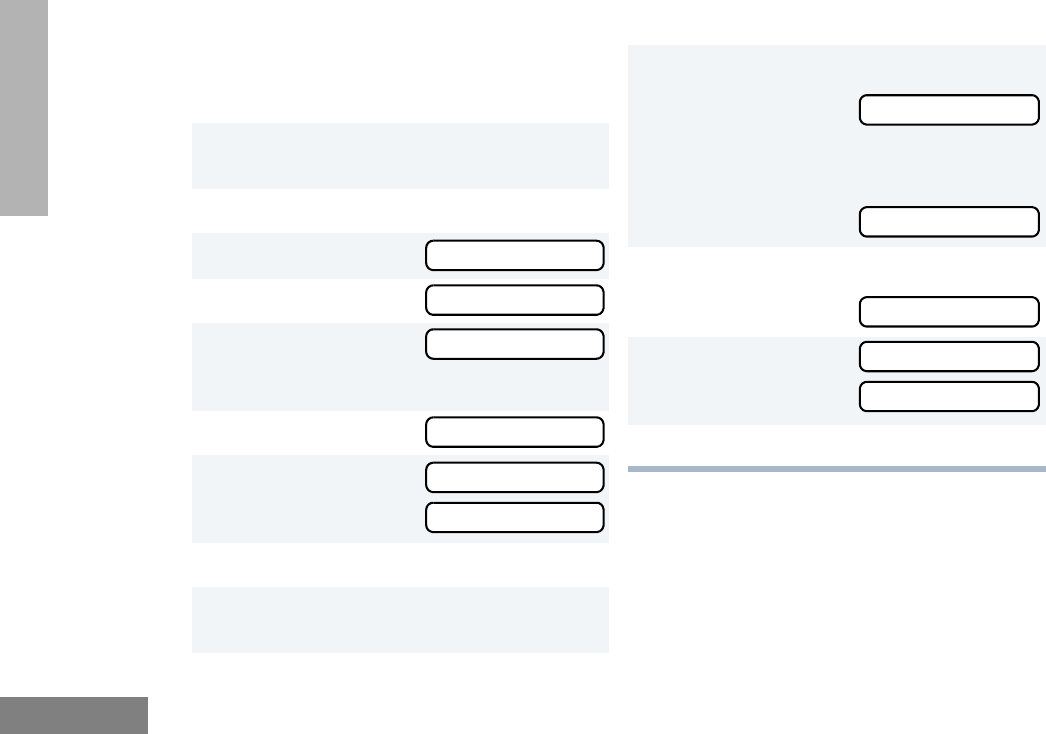
30
English
SCAN
Note: Your radio cannot receive any calls
while you are editing a Scan list.
ADD OR DELETE CHANNELS IN A
SCAN LIST
1G or H to select a channel that contains a
Scan list you want to edit.
2D to enter menu mode.
3G or H until
4D to select
5G or H until
Note: One Scan list per channel is available.
6D to select
7G or H until
– or – until
8D to select the current setting.
9G or H until you see the channel you want
to add or delete.
PROG LST
PROG LST
SCAN LST
SCAN LST
ADD ITEM
DELETE
10 D to confirm your selection.
11 If you added a channel,
you see:
– or –
If you delete a channel,
you see:
12 D to confirm the deletion.
you see:
13 C to return to
– or –
14 C until you exit menu mode.
ADDED
DELETE
DELETED
ADD ITEM
DELETE
04_Scan.fm Page 30 Friday, July 11, 2003 11:31 AM
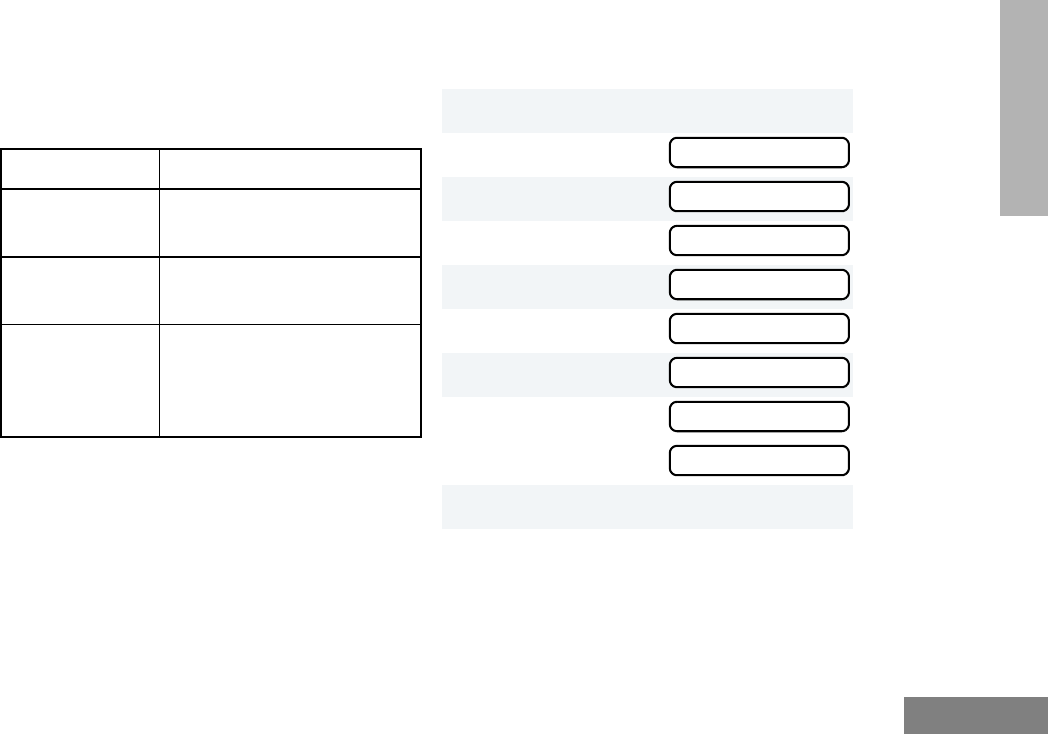
31
English
SCAN
PRIORITIZE A CHANNEL IN A SCAN
LIST
You may want to check the activity on one or
two channels more frequently than others. You
can do this by prioritizing them:
Note: If you are receiving on a non-priority
channel and traffic becomes active on a
priority channel, your radio will automat-
ically switch to that priority channel and
indicate the activity with a short tone.
Set Priority Channels
Note: You cannot have the same priority on
two different channels.
Priority Channel Scanning Sequence
None specified Ch1➠Ch2➠Ch3➠
Ch4➠…Ch1
Channel 2
(Priority 1) Ch2➠Ch1➠Ch2➠Ch3➠
Ch2➠Ch4➠Ch2➠…Ch1
Channel 2
(Priority 1) and
Channel 8
(Priority 2)
Ch2➠Ch1➠Ch8➠Ch3➠
Ch2➠Ch4➠Ch8➠…Ch1
1D to enter menu mode.
2G or H until
3D to select
4G or H until
5D to select
6G or H until
7D to select
8G or H until
– or – until
9D to select the desired priority level.
You see the current priority channel.
10 G or H until you see the channel you want
to prioritize.
PROG LST
PROG LST
SCAN LST
SCAN LST
EDIT PRI
EDIT PRI
PRI #1
PRI #2
04_Scan.fm Page 31 Friday, July 11, 2003 11:31 AM

32
English
SCAN
11 D to prioritize that channel.
you see:
12 C to return to
13 C until you exit menu mode.
SAVED
EDIT PRI
04_Scan.fm Page 32 Friday, July 11, 2003 11:31 AM

33
English
PHONE
PHONE
Your radio allows you to place and receive
telephone calls through a repeater (depending
on phone line availability). You can edit the
phone list through your radio’s menu (see page
36).
•D appears on the display when you are in
Phone mode.
Your dealer/programmer can preprogram your
radio in one of three ways to enter your access/
de-access code to the repeater.
Immediate Auto – your radio will transmit the
access/deaccess code automatically upon
entering phone mode or disconnecting a
phone call. You will hear a series of tones, and
see your access/deaccess code on the display,
indicating that an access/deaccess code is
being sent automatically.
Delayed Auto – your radio will transmit the
access code upon a PTT button press. The de-
access code is sent automatically when you
exit phone mode.
Manual - Enter your access/deaccess code
using the DTMF microphone keypad and press
the PTT button.
RECEIVE A PHONE CALL D
When a phone call is received, a ringing tone
sounds, alerting you to answer the phone call.
Press the preprogrammed Phone button (see
page 14), and skip to step 6.
– or –
Press the PTT button, and if the Hot Keypad
feature has been preprogrammed by your
dealer/programmer, do the following:
1G or H to select a channel that has been
programmed for telephone.
2D to enter menu mode.
3G or H until
4D to select
Note: The D appears on the display.
PHONE
PHONE
05_Phone.fm Page 33 Friday, July 11, 2003 11:32 AM

34
English
PHONE
MAKE A PHONE CALL D
Press the preprogrammed Phone button (see
page 14), and skip to step 6.
– or –
Press the PTT button, and if the Hot Keypad
feature has been preprogrammed by your
dealer/programmer, do the following:
5Your dealer/programmer can preprogram your
radio in one of three ways to enter your
access code to the repeater.
Immediate Auto – automatically sends the
access code.
Delayed Auto – your radio will transmit the
access code upon a PTT button press.
Manual - Enter your access code using the
DTMF microphone keypad and press the PTT
button.
6Hold the radio in a vertical position with the
microphone 1 to 2 inches (2.5 to 5 cm) away
from your mouth. Press and hold the PTT but-
ton to talk. Release the PTT button when the
other party wants to talk, both parties will
need to speak in turn.
7To disconnect a phone call, do one of the
following:
If your radio has Immediate Auto or Delayed
Auto programmed, go to step 8.
– or –
Enter the deaccess code using the DTMF
microphone keypad and press the PTT but-
ton.
8To exit Phone Mode:
Press the preprogrammed Phone button (see
page 14).
– or –
Press and hold C to disconnect the call.
Note: D disappears from the display.
1G or H to select a channel that has been
programmed for telephone.
2D to enter menu mode.
3G or H until
4D to select
PHONE
PHONE
05_Phone.fm Page 34 Friday, July 11, 2003 11:32 AM

35
English
PHONE
5Your dealer/programmer can preprogram your
radio in one of three ways to enter your
access code to the repeater.
Immediate Auto – automatically sends the
access code.
Delayed Auto – your radio will transmit the
access code upon a PTT button press.
Manual - Enter your access code using the
DTMF microphone keypad and press the PTT
button.
6When you hear a dial tone:
Enter the phone num-
ber using the DTMF
microphone keypad.
The number will scroll
to the left,
– or –
G or H to select a
number from the
phone list.
Note: Only the first 8 digits are displayed.
– or –
XXXXXXX
XXXXXXXX
a. Press and release the preprogrammed
Speed Dial button.
b. Press the key (0 to 9) corresponding to
the number you want to call.
Note: To redial the last number dialed (if
not using Speed Dial), press and
release the PTT button immediately
after the access code is sent. The
radio sends the last number dialed.
– or –
If you entered your access code
using the DTMF keypad, press G
once to access the last number
dialed; then press and release the
PTT button.
7Press and release the PTT button, if required
for your radio.
8Hold the radio in a vertical position with the
microphone 1 to 2 inches (2.5 to 5 cm) away
from your mouth. Press and hold the PTT but-
ton to talk. Release the PTT button when the
other party wants to talk, both parties will
need to speak in turn.
05_Phone.fm Page 35 Friday, July 11, 2003 11:32 AM

36
English
PHONE
EDIT THE PHONE LIST
Your radio contains a Phone list that holds up
to 25 phone numbers. You can edit the Phone
list in three ways through your radio’s menu:
• Add an entry
• Delete an entry
• Edit an existing entry
Add an Entry
9To disconnect a phone call, do one of the
following:
If your radio has Immediate Auto or Delayed
Auto programmed, go to step 10.
– or –
Enter the deaccess code using the DTMF
microphone keypad and press the PTT but-
ton.
10 To exit Phone Mode:
Press the preprogrammed Phone button (see
page 14).
– or –
Press and hold C to disconnect the call.
Note: D disappears from the display.
1D to enter menu mode.
2G or H until
3D to select
4G or H until
5D to select
6G or H until
7D to select,
you see:
8Use the DTMF microphone keypad to enter
the name (see Entering Characters Using the
DTMF Microphone Keypad on page 10).
9D to store the name,
you see:
PROG LST
PROG LST
PHN LST
PHN LST
ADD ITEM
ADD ITEM
NAME
NUMBER
05_Phone.fm Page 36 Friday, July 11, 2003 11:32 AM
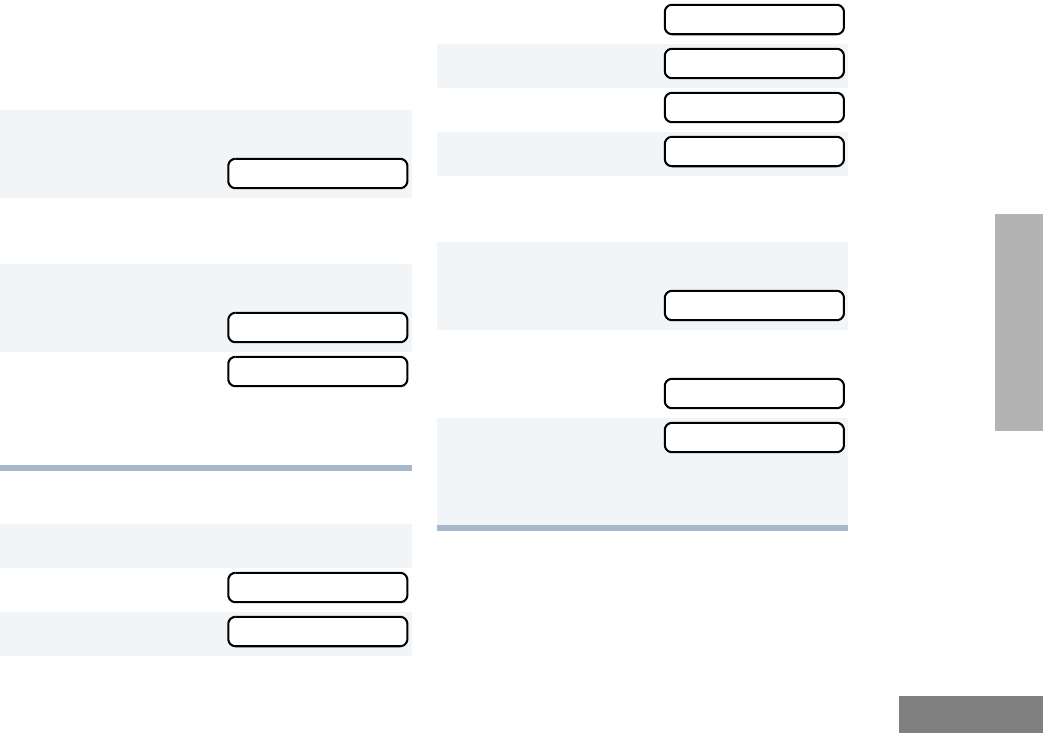
37
English
PHONE
Delete an Entry
10 Use the DTMF microphone keypad to enter the
phone number. You can also add a Pause
Indicator (press # three times until the #
character on the display changes to a “-”).
11 D to store the phone number.
you see:
12 G or H until you see the location in the list
where you want to store the phone number.
13 D to store the location.
you see:
14 C to return to
– or –
C until you exit menu mode.
1D to enter menu mode.
2G or H until
3D to select
LOC XX
SAVED
ADD ITEM
PROG LST
PROG LST
4G or H until
5D to select
6G or H until
7D to select
8G or H until you see the entry you want to
delete.
9D to select the entry,
you see:
10 D again to confirm the deletion,
you see:
11 C to return to
– or –
C until you exit menu mode.
PHN LST
PHN LST
DELETE
DELETE
DELETE
DELETED
DELETE
05_Phone.fm Page 37 Friday, July 11, 2003 11:32 AM
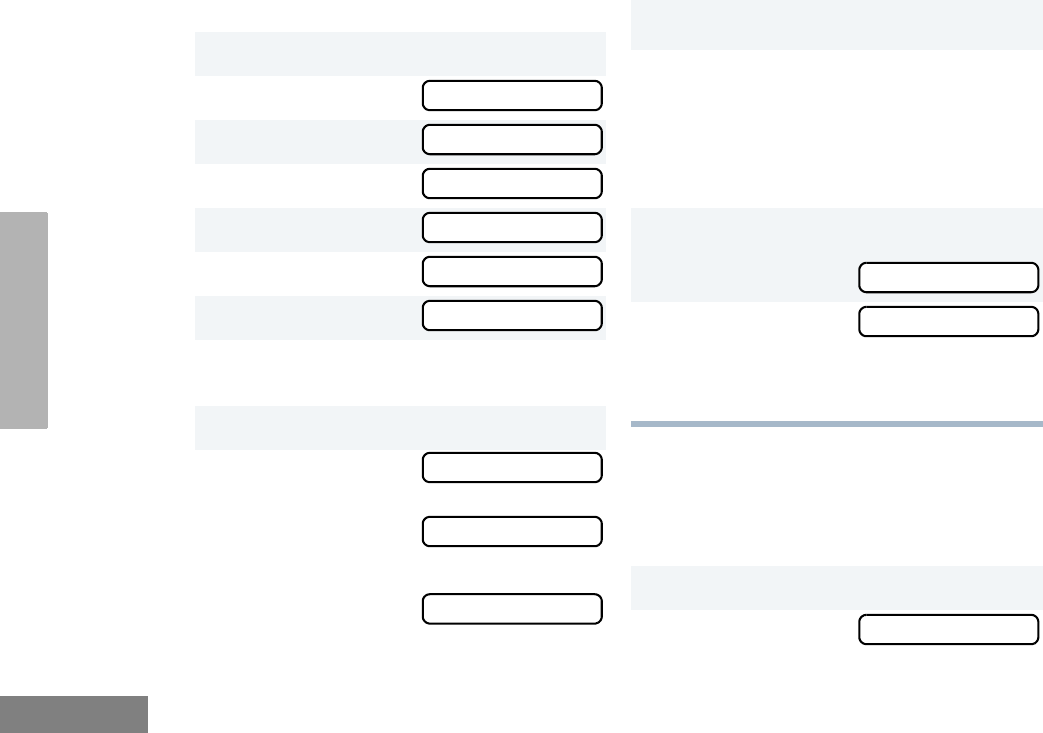
38
English
PHONE
Edit an Entry
Edit Access/Deaccess Codes
You can edit the access/de-access codes that
are used to connect or disconnect you from a
repeater.
1D to enter menu mode.
2G or H until
3D to select
4G or H until
5D to select
6G or H until
7D to select
8G or H until you see the entry you want to
edit.
9D to select the entry.
10 G or H u n ti l
(to edit the name),
– or – until
(to edit the phone
number),
– or – until
(to edit the location in
the phone list).
PROG LST
PROG LST
PHN LST
PHN LST
EDIT
EDIT
NAME
NUMBER
LOC
11 D to confirm your selection.
12 Use the DTMF microphone keypad to edit the
entry (see Entering Characters Using the
DTMF Microphone Keypad on page 10),
– or –
G or H until you see the location where
you want to store the phone number.
13 D to store the information.
you see:
14 C to return to
– or –
C until you exit menu mode.
1D to enter menu mode.
2G or H until
SAVED
EDIT
PROG LST
05_Phone.fm Page 38 Friday, July 11, 2003 11:32 AM
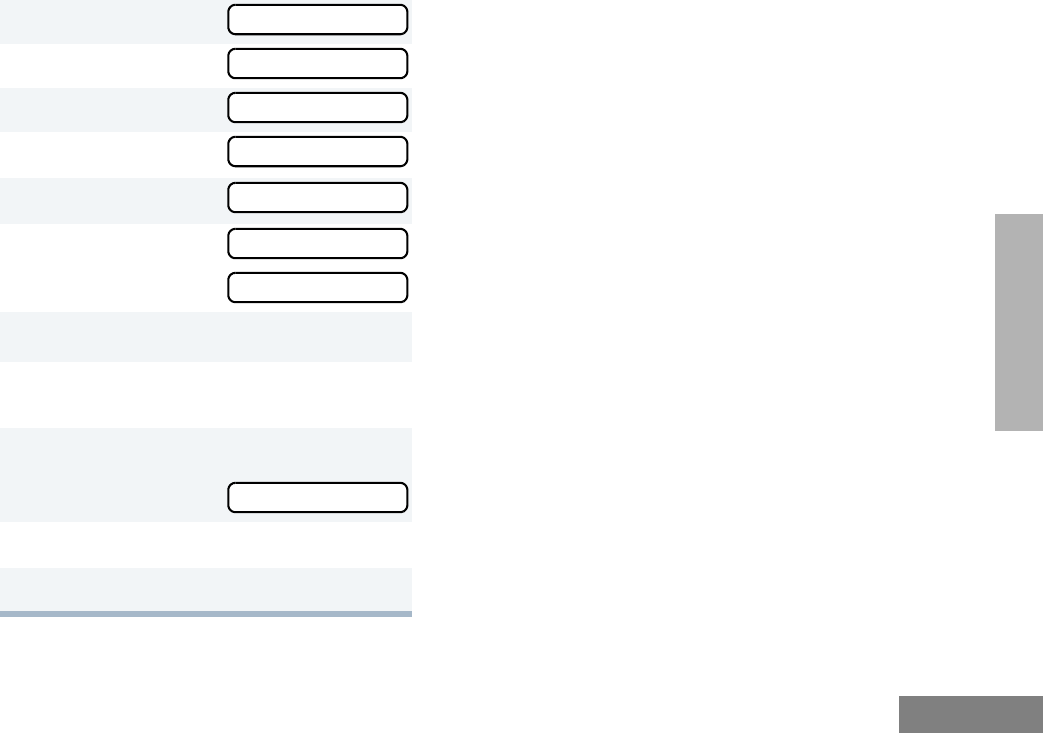
39
English
PHONE
3D to select
4G or H until
5D to select
6G or H until
7D to select
8G or H until
– or – until
9D to select the current setting.
10 Enter the number using the DTMF keypad
microphone.
11 D to select the entry.
you see:
12 G or H to edit another code.
13 C until you exit menu mode.
PROG LST
PHN LST
PHN LST
EDT CODE
EDT CODE
ACCESS
DEACCESS
SAVED
05_Phone.fm Page 39 Friday, July 11, 2003 11:32 AM

40
English
PHONE
Notes:
05_Phone.fm Page 40 Friday, July 11, 2003 11:32 AM
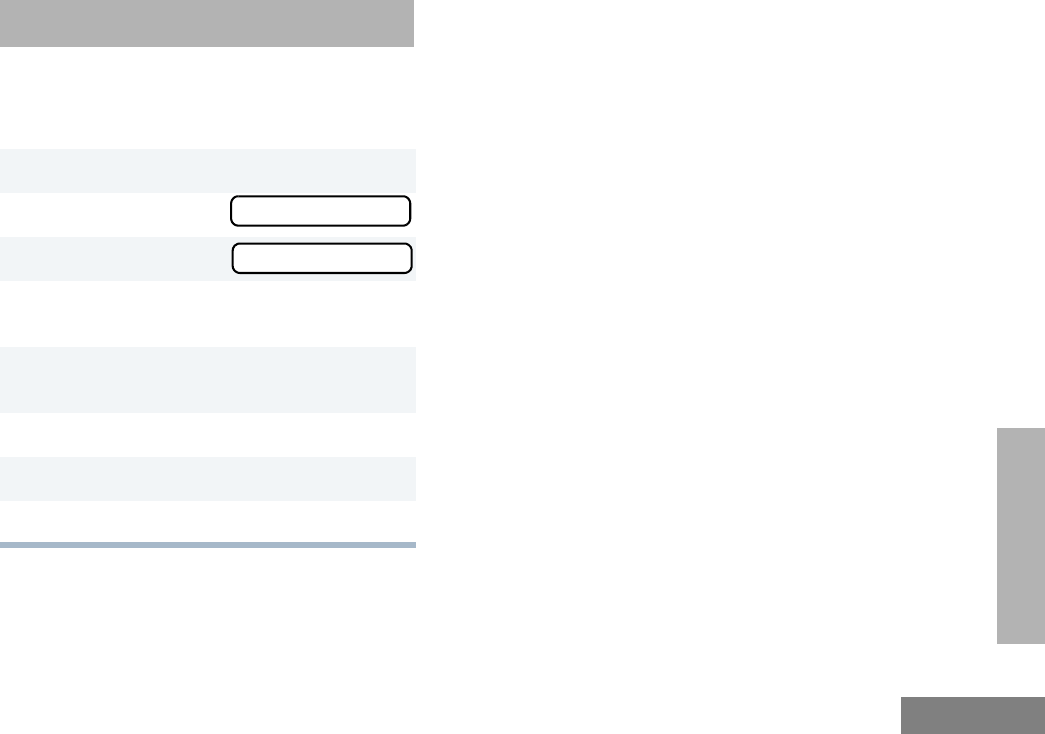
41
English
TONE PREFERENCES
TONE PREFERENCES
You can use the radio’s menu to access user-
adjustable settings to customize the tones on
your radio by:
1D to enter menu mode.
2G or H until
3D to select
4G or H until you see the feature you want
to change (see the table on page 42).
5D to select the feature. You see the
feature’s current setting.
6G or H to see a list of available settings.
7D to select the desired setting.
8C until you exit the menu mode.
TONES
TONES
06_Tone.fm Page 41 Friday, July 11, 2003 11:05 AM
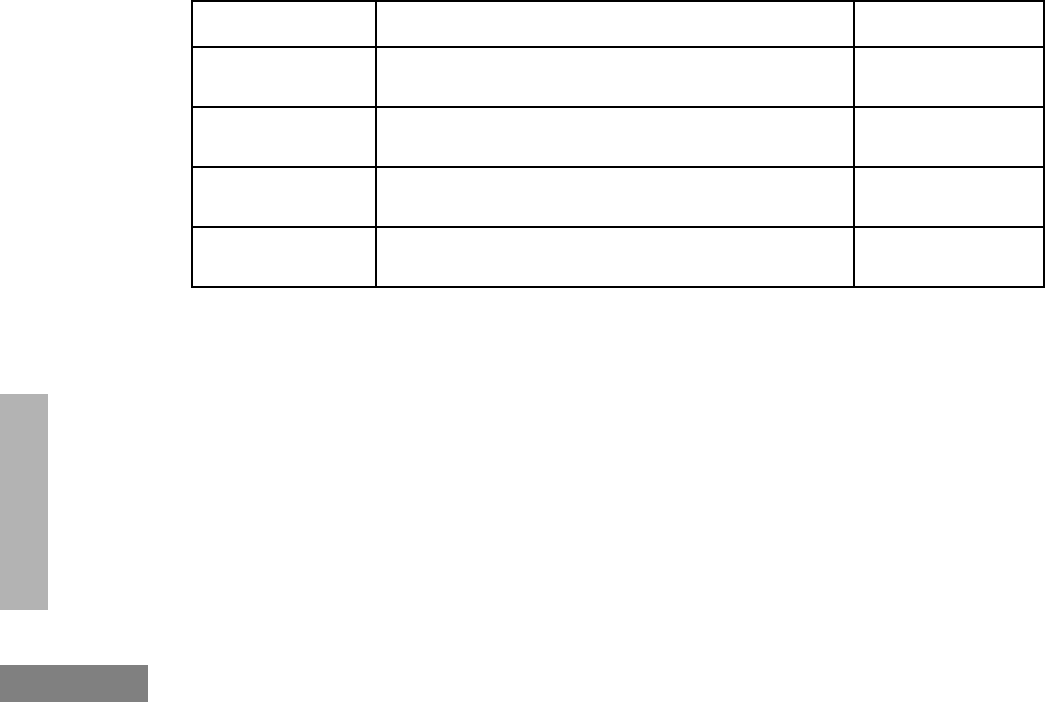
42
English
TONE PREFERENCES
Tone Settings
Feature What it Does Settings
TONE Turns all alert tones on or off. ON
OFF
KPD TONE Turns the keypad tones on or off. ON
OFF
TONE TAG Assigns a specific tone when receiving a specific type of
radio call.
STANDARD
ALERT 1 – 6
ESCALERT Increases the volume of the alarm tones when a radio
call is not answered.
ON
OFF
06_Tone.fm Page 42 Friday, July 11, 2003 11:05 AM
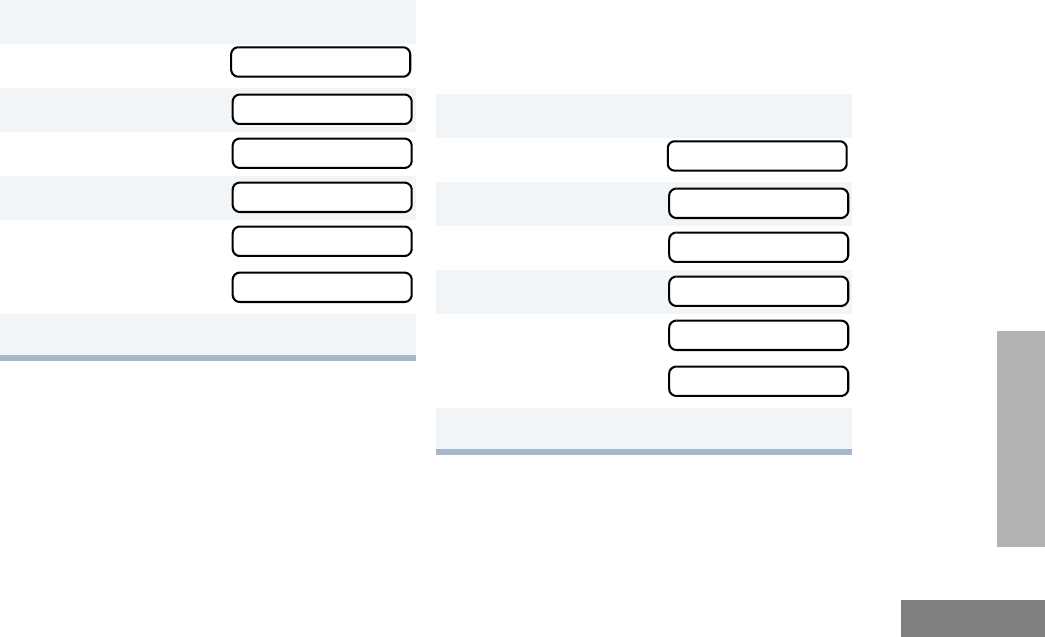
43
English
TONE PREFERENCES
TONES ON/OFF
You can program your radio to enable or
disable all alert tones.
KEYPAD ON/OFF TONES
You can program your radio to enable or
disable all keypad tones.
Note: Tones for the programmable buttons
C, D, E, and F can not be
disabled.
1D to enter Menu mode.
2G or H until
3D to select
4G or H until
5D to select
6G or H until
– or – until
7D to select the desired setting.
TONES
TONES
TONE
TONE
ON
OFF
1D to enter Menu mode.
2G or H until
3D to select
4G or H until
5D to select
6G or H until
– or – until
7D to select the desired setting.
TONES
TONES
KPD TONE
KPD TONE
ON
OFF
06_Tone.fm Page 43 Monday, July 14, 2003 10:21 AM
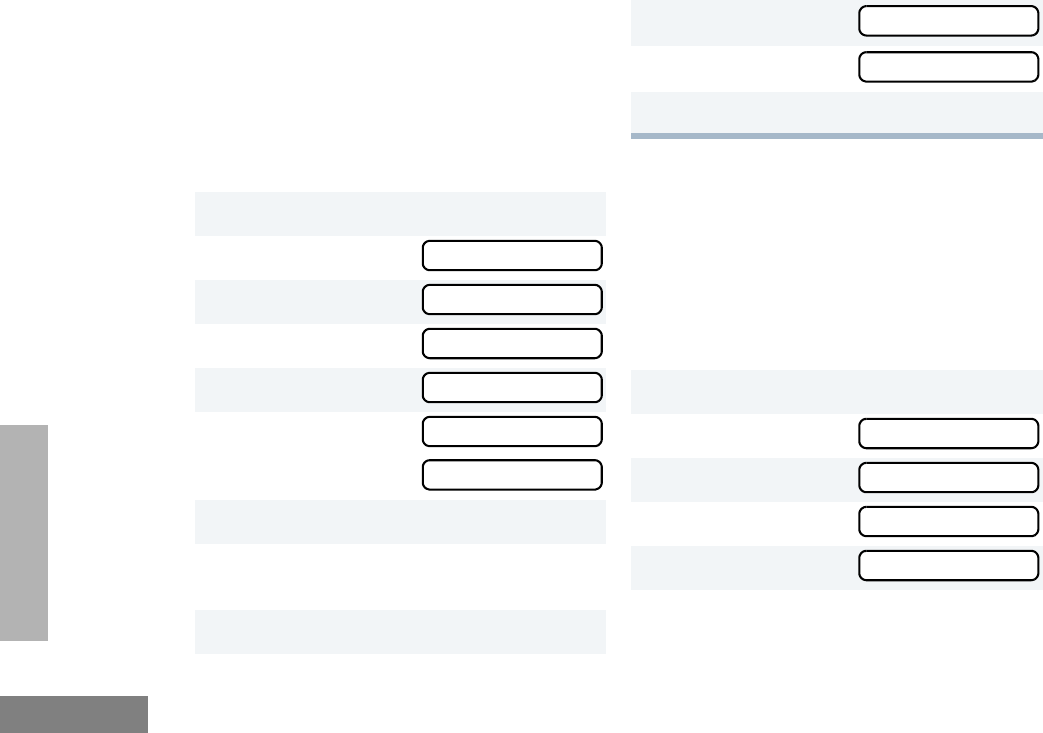
44
English
TONE PREFERENCES
CALL TONE TAGGING
You can program your radio to sound a
particular alert tone when receiving a Selective
Call or Call Alert (call tone tagging).
Note: Seven alert tones are available to
select from in the list. ESCALERT
You can program your radio to increase the
volume of the alarm tones when a radio call is
not answered.
Press the preprogrammed Escalert button
(see page 14) and proceed to step 5.
– or –
1D to enter menu mode.
2G or H until
3D to select
4G or H until
5D to select
6G or H until
– or – until
7D to select the desired setting.
8G or H until you see and hear the tone you
want to use for this type of call.
9D to select the desired setting,
TONES
TONES
TONE TAG
TONE TAG
CALL ALT
SEL CALL
you see:
10 C to return to
11 C until you exit the menu mode.
1D to enter menu mode.
2G or H until
3D to select
4G or H until
5D to select
TONE SET
TONE TAG
TONES
TONES
ESCALERT
ESCALERT
06_Tone.fm Page 44 Monday, July 14, 2003 10:21 AM
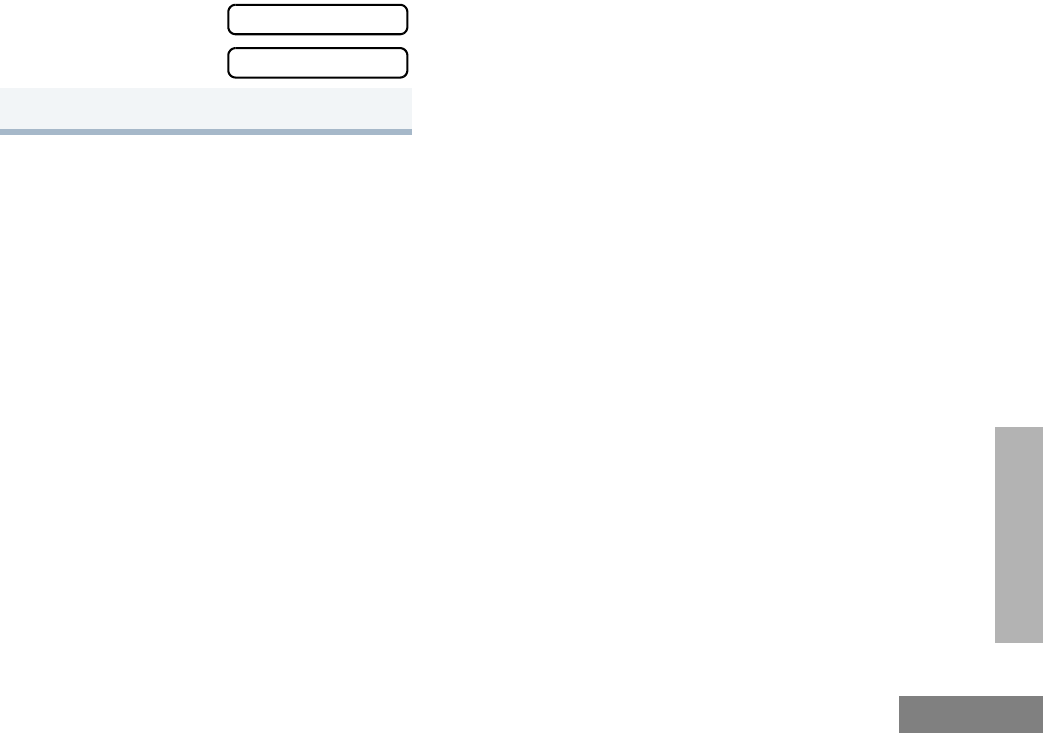
45
English
TONE PREFERENCES
6G or H until
– or – until
7D to select the desired setting.
ON
OFF
06_Tone.fm Page 45 Monday, July 14, 2003 10:21 AM

46
English
TONE PREFERENCES
Notes:
06_Tone.fm Page 46 Monday, July 14, 2003 10:21 AM
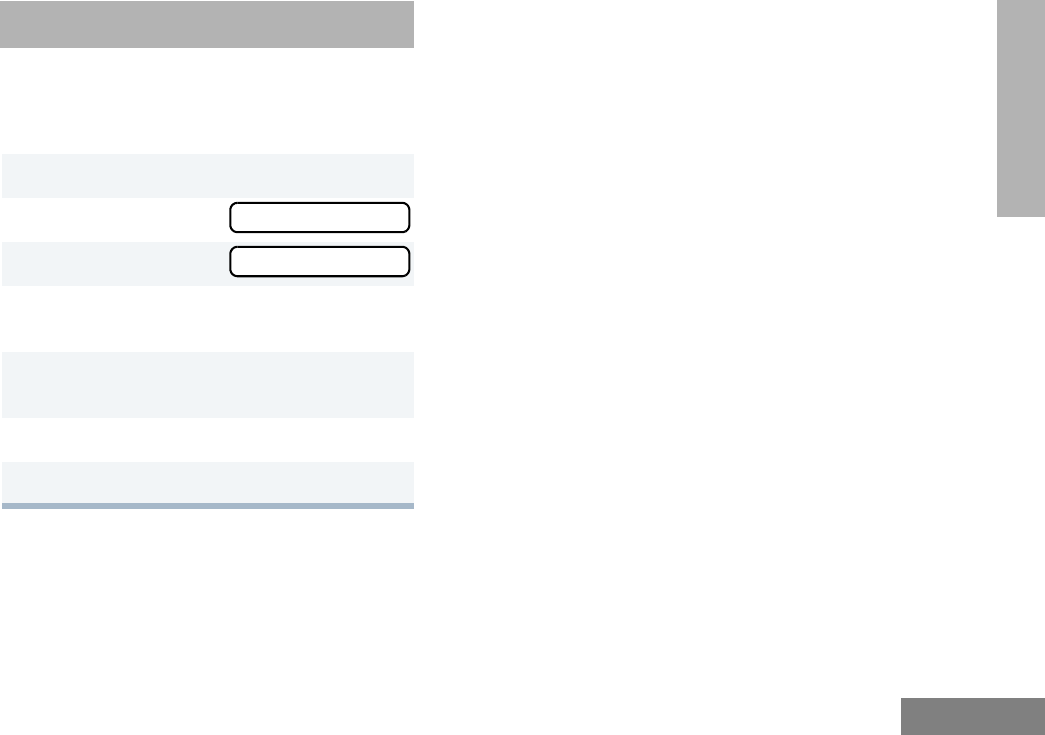
47
English
USER SETTINGS
USER SETTINGS
You can use the radio’s menu to access user-
adjustable settings to customize some of your
radio features by:
1D to enter menu mode.
2G or H until
3D to select
4G or H until you see the feature you want
to change (see the table on page 48).
5D to select the feature. You see the fea-
ture’s current setting.
6G or H for available settings.
7D to select the desired setting.
UTILITY
UTILITY
07_Utilities.fm Page 47 Friday, July 11, 2003 11:08 AM
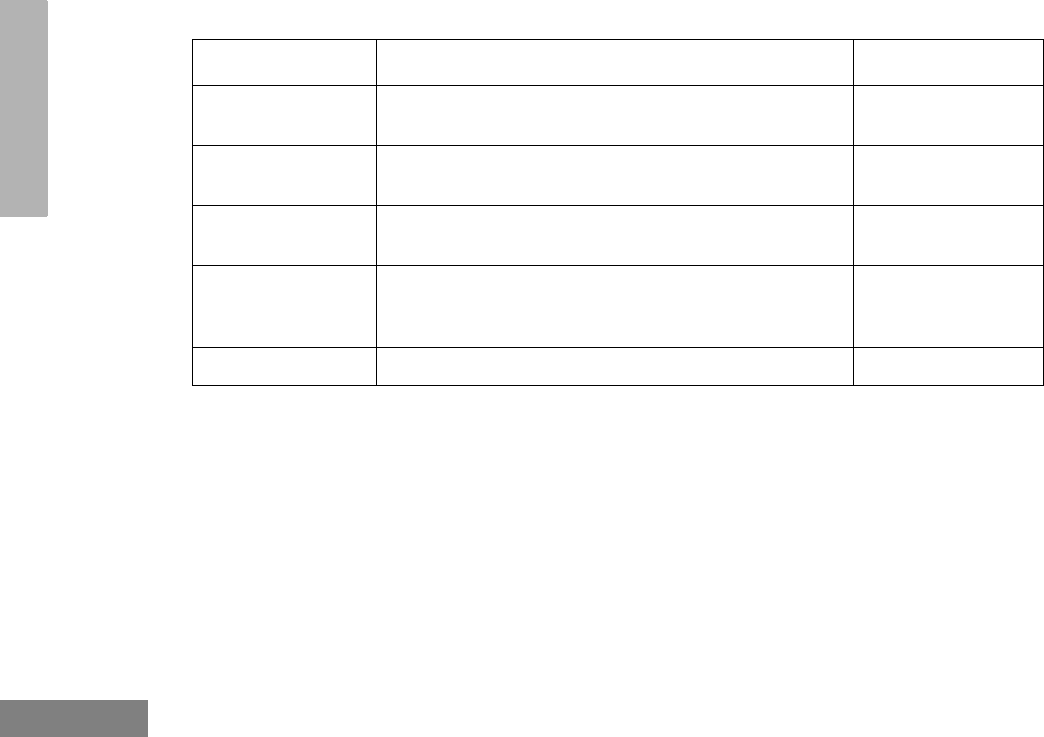
48
English
USER SETTINGS
Utilities Features
Feature What it Does Settings
SQUELCH Changes the squelch of the radio to tight or normal. TIGHT
NORMAL
PWR LVL Changes the power level of the radio to high or low. HIGH
LOW
OPT BRD Enables or disables an option board. ON
OFF
BKLT INT Changes the brightness of the backlight. HIGH
MED
LOW
SOFTWARE Displays the radio’s software version number. XX’XX’XX
07_Utilities.fm Page 48 Friday, July 11, 2003 11:08 AM
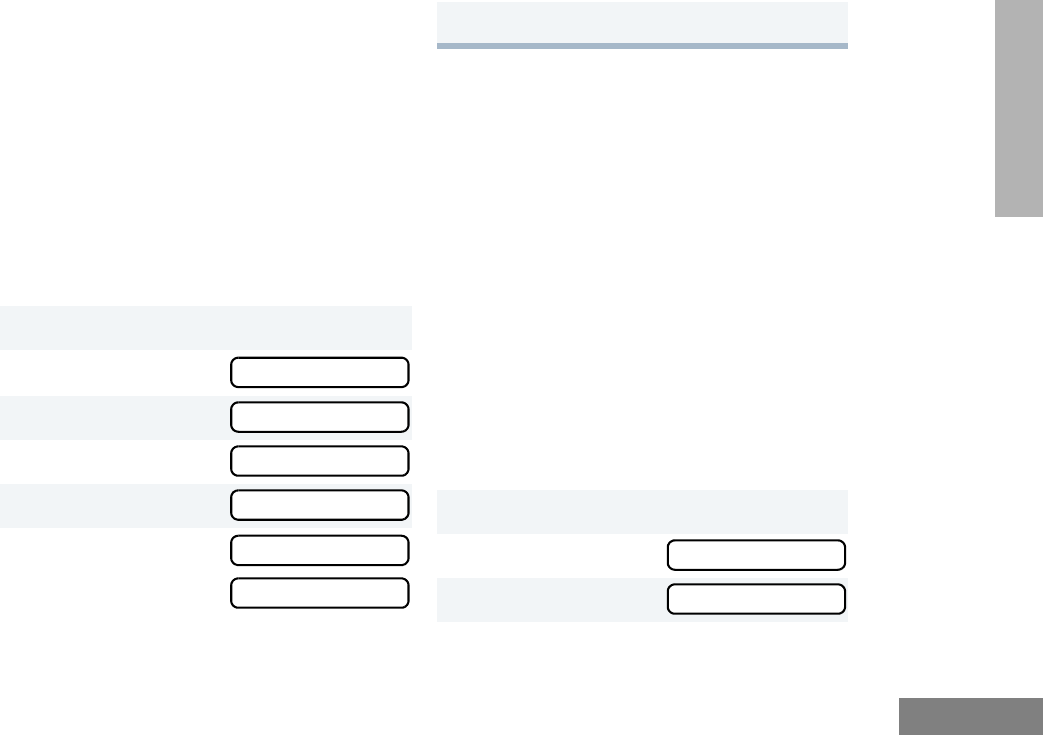
49
English
USER SETTINGS
SET SQUELCH LEVEL
Use this feature to filter out nuisance
(unwanted) calls and/or background noise.
However, tightening squelch could cause calls
from remote locations to be filtered out as well.
In this case, normal squelch may be more
desirable.
Press the preprogrammed Squelch button
(see page 14) to toggle between tight and
normal squelch.
– or –
SET POWER LEVEL B
Each channel in your radio has a predefined
transmit power level that can be changed.
•High power (S) allows you to reach a radio
that is farther away.
•Low power (R) to reach a radio within close
proximity.
Note: The R or S symbol appears on the
display when High/Low Power Level is
selected.
To set the power level, press the
preprogrammed Power Level button (see
page 14) to toggle between low and high
power.
– or –
1D to enter menu mode.
2G or H until
3D to select
4G or H until
5D to select
6G or H until
-or - until
UTILITY
UTILITY
SQUELCH
SQUELCH
NORMAL
TIGHT
7D to select the current setting.
1D to enter menu mode.
2G or H until
3D to select
UTILITY
UTILITY
07_Utilities.fm Page 49 Friday, July 11, 2003 11:08 AM
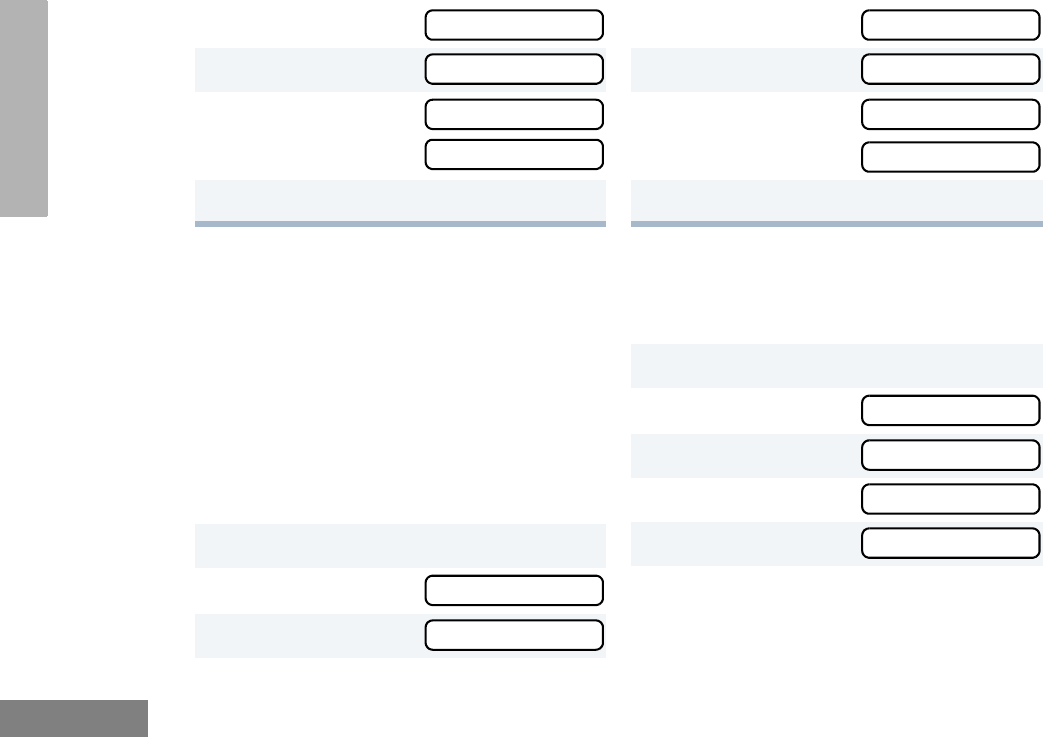
50
English
USER SETTINGS
OPTION BOARD ON/OFF A
Use this feature to enable or disable an option
board.
•The
A symbol appears on the display
when the option board feature is On.
Press the preprogrammed Option Board
button (see page 14) to toggle the option board
on or off.
– or –
SET THE BACKLIGHT INTENSITY
Use this feature to change the brightness of
the backlight.
4G or H until
5D to select
6G or H until
-or - until
7D to select the current setting.
1D to enter menu mode.
2G or H until
3D to select
PWR LVL
PWR LVL
HIGH
LOW
UTILITY
UTILITY
4G or H until
5D to select
6G or H until
-or- until
7D to select the current setting.
1D to enter menu mode.
2G or H until
3D to select
4G or H until
5D to select
OPT BRD
OPT BRD
ON
OFF
UTILITY
UTILITY
BKLT INT
BKLT INT
07_Utilities.fm Page 50 Friday, July 11, 2003 11:08 AM
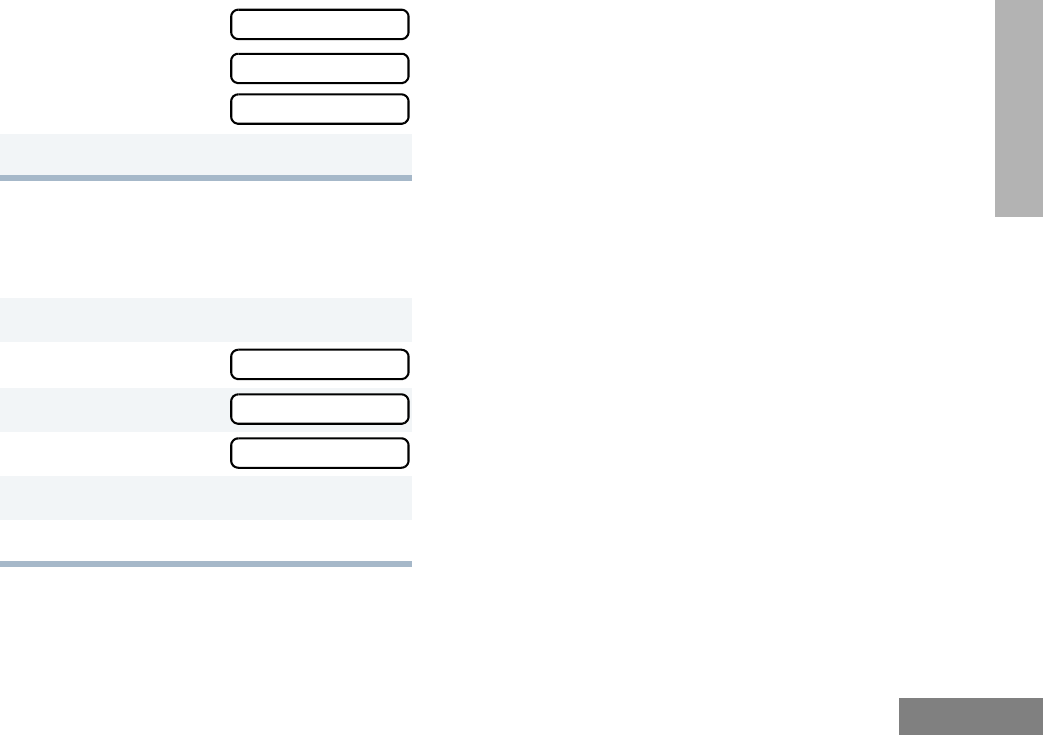
51
English
USER SETTINGS
DISPLAY THE SOFTWARE VERSION
Use this feature to view the current software
version of your radio.
6G or H until
-or- until
-or- until
7D to select the current setting.
1D to enter menu mode.
2G or H until
3D to select
4G or H until
5D to view the software version.
6C until you exit menu mode.
HIGH
MED
LOW
UTILITY
UTILITY
SOFTWARE
07_Utilities.fm Page 51 Friday, July 11, 2003 11:08 AM

52
English
USER SETTINGS
Notes:
07_Utilities.fm Page 52 Friday, July 11, 2003 11:08 AM

53
English
WARRANTY
WARRANTY
LIMITED WARRANTY
MOTOROLA COMMUNICATION
PRODUCTS
I. WHAT THIS WARRANTY COVERS AND
FOR HOW LONG:
MOTOROLA INC. (“MOTOROLA”) warrants the
MOTOROLA manufactured Communication
Products listed below (“Product”) against defects
in material and workmanship under normal use
and service for a period of time from the date of
purchase as scheduled below:
CM300 Mobile Units Two (2) Years
Product Accessories One (1) Year
Motorola, at its option, will at no charge either
repair the Product (with new or reconditioned
parts), replace it (with a new or reconditioned
Product), or refund the purchase price of the
Product during the warranty period provided it is
returned in accordance with the terms of this
warranty. Replaced parts or boards are warranted
for the balance of the original applicable warranty
period. All replaced parts of Product shall become
the property of MOTOROLA.
This express limited warranty is extended by
MOTOROLA to the original end user purchaser
only and is not assignable or transferable to any
other party. This is the complete warranty for the
Product manufactured by MOTOROLA.
MOTOROLA assumes no obligations or liability
for additions or modifications to this warranty
unless made in writing and signed by an officer
of MOTOROLA. Unless made in a separate
agreement between MOTOROLA and the
original end user purchaser, MOTOROLA does
not warrant the installation, maintenance or
service of the Product.
MOTOROLA cannot be responsible in any way
for any ancillary equipment not furnished by
MOTOROLA which is attached to or used in
connection with the Product, or for operation of
the Product with any ancillary equipment, and all
such equipment is expressly excluded from this
warranty. Because each system which may use
the Product is unique, MOTOROLA disclaims
liability for range, coverage, or operation of the
system as a whole under this warranty.
08_Warranty.fm Page 53 Friday, July 11, 2003 11:12 AM

54
English
WARRANTY
II. GENERAL PROVISIONS:
This warranty sets forth the full extent of
MOTOROLA'S responsibilities regarding the
Product. Repair, replacement or refund of the
purchase price, at MOTOROLA’s option, is the
exclusive remedy. THIS WARRANTY IS GIVEN
IN LIEU OF ALL OTHER EXPRESS
WARRANTIES. IMPLIED WARRANTIES,
INCLUDING WITHOUT LIMITATION, IMPLIED
WARRANTIES OF MERCHANTABILITY AND
FITNESS FOR A PARTICULAR PURPOSE, ARE
LIMITED TO THE DURATION OF THIS LIMITED
WARRANTY. IN NO EVENT SHALL MOTOROLA
BE LIABLE FOR DAMAGES IN EXCESS OF
THE PURCHASE PRICE OF THE PRODUCT,
FOR ANY LOSS OF USE, LOSS OF TIME,
INCONVENIENCE, COMMERCIAL LOSS, LOST
PROFITS OR SAVINGS OR OTHER
INCIDENTAL, SPECIAL OR CONSEQUENTIAL
DAMAGES ARISING OUT OF THE USE OR
INABILITY TO USE SUCH PRODUCT, TO THE
FULL EXTENT SUCH MAY BE DISCLAIMED BY
LAW.
III. STATE LAW RIGHTS:
SOME STATES DO NOT ALLOW THE
EXCLUSION OR LIMITATION OF INCIDENTAL
OR CONSEQUENTIAL DAMAGES OR
LIMITATION ON HOW LONG AN IMPLIED
WARRANTY LASTS, SO THE ABOVE
LIMITATION OR EXCLUSIONS MAY NOT APPLY.
This warranty gives specific legal rights, and there
may be other rights which may vary from state to
state.
IV. HOW TO GET WARRANTY SERVICE:
You must provide proof of purchase (bearing the
date of purchase and Product item serial
number) in order to receive warranty service and,
also, deliver or send the Product item,
transportation and insurance prepaid, to an
authorized warranty service location. Warranty
service will be provided by Motorola through one
of its authorized warranty service locations. If you
first contact the company which sold you the
Product (e.g., dealer or communication service
provider), it can facilitate your obtaining warranty
service. You can also call Motorola at 1-800-927-
2744 US/Canada.
08_Warranty.fm Page 54 Friday, July 11, 2003 11:12 AM

55
English
WARRANTY
V. WHAT THIS WARRANTY DOES NOT
COVER:
A) Defects or damage resulting from use of the
Product in other than its normal and
customary manner.
B) Defects or damage from misuse, accident,
water, or neglect.
C) Defects or damage from improper testing,
operation, maintenance, installation,
alteration, modification, or adjustment.
D) Breakage or damage to antennas unless
caused directly by defects in material
workmanship.
E) A Product subjected to unauthorized
Product modifications, disassembles or
repairs (including, without limitation, the
addition to the Product of non-Motorola
supplied equipment) which adversely affect
performance of the Product or interfere with
Motorola's normal warranty inspection and
testing of the Product to verify any warranty
claim.
F) Product which has had the serial number
removed or made illegible.
G) Rechargeable batteries if:
1) any of the seals on the battery
enclosure of cells are broken or show
evidence of tampering.
2) the damage or defect is caused by
charging or using the battery in
equipment or service other than the
Product for which it is specified.
H) Freight costs to the repair depot.
I) A Product which, due to illegal or
unauthorized alteration of the software/
firmware in the Product, does not function in
accordance with MOTOROLA’s published
specifications or the FCC type acceptance
labeling in effect for the Product at the time
the Product was initially distributed from
MOTOROLA.
J) Scratches or other cosmetic damage to
Product surfaces that does not affect the
operation of the Product.
K) Normal and customary wear and tear.
VI. PATENT AND SOFTWARE PROVISIONS:
MOTOROLA will defend, at its own expense, any
suit brought against the end user purchaser to
the extent that it is based on a claim that the
Product or parts infringe a United States patent,
and MOTOROLA will pay those costs and
damages finally awarded against the end user
purchaser in any such suit which are attributable
to any such claim, but such defense and
payments are conditioned on the following:
08_Warranty.fm Page 55 Friday, July 11, 2003 11:12 AM

56
English
WARRANTY
A) that MOTOROLA will be notified promptly in
writing by such purchaser of any notice of
such claim;
B) that MOTOROLA will have sole control of the
defense of such suit and all negotiations for
its settlement or compromise; and
C) should the Product or parts become, or in
MOTOROLA’s opinion be likely to become,
the subject of a claim of infringement of a
United States patent, that such purchaser
will permit MOTOROLA, at its option and
expense, either to procure for such
purchaser the right to continue using the
Product or parts or to replace or modify the
same so that it becomes non-infringing or to
grant such purchaser a credit for the Product
or parts as depreciated and accept its
return. The depreciation will be an equal
amount per year over the lifetime of the
Product or parts as established by
MOTOROLA.
MOTOROLA will have no liability with respect to
any claim of patent infringement which is based
upon the combination of the Product or parts
furnished hereunder with software, apparatus or
devices not furnished by MOTOROLA, nor will
MOTOROLA have any liability for the use of
ancillary equipment or software not furnished by
MOTOROLA which is attached to or used in
connection with the Product. The foregoing
states the entire liability of MOTOROLA with
respect to infringement of patents by the Product
or any parts thereof.
Laws in the United States and other countries
preserve for MOTOROLA certain exclusive rights
for copyrighted MOTOROLA software such as
the exclusive rights to reproduce in copies and
distribute copies of such Motorola software.
MOTOROLA software may be used in only the
Product in which the software was originally
embodied and such software in such Product
may not be replaced, copied, distributed,
modified in any way, or used to produce any
derivative thereof. No other use including, without
limitation, alteration, modification, reproduction,
distribution, or reverse engineering of such
MOTOROLA software or exercise of rights in
such MOTOROLA software is permitted. No
license is granted by implication, estoppel or
otherwise under MOTOROLA patent rights or
copyrights.
VII. GOVERNING LAW:
This Warranty is governed by the laws of the
State of Illinois, USA.
08_Warranty.fm Page 56 Friday, July 11, 2003 11:12 AM
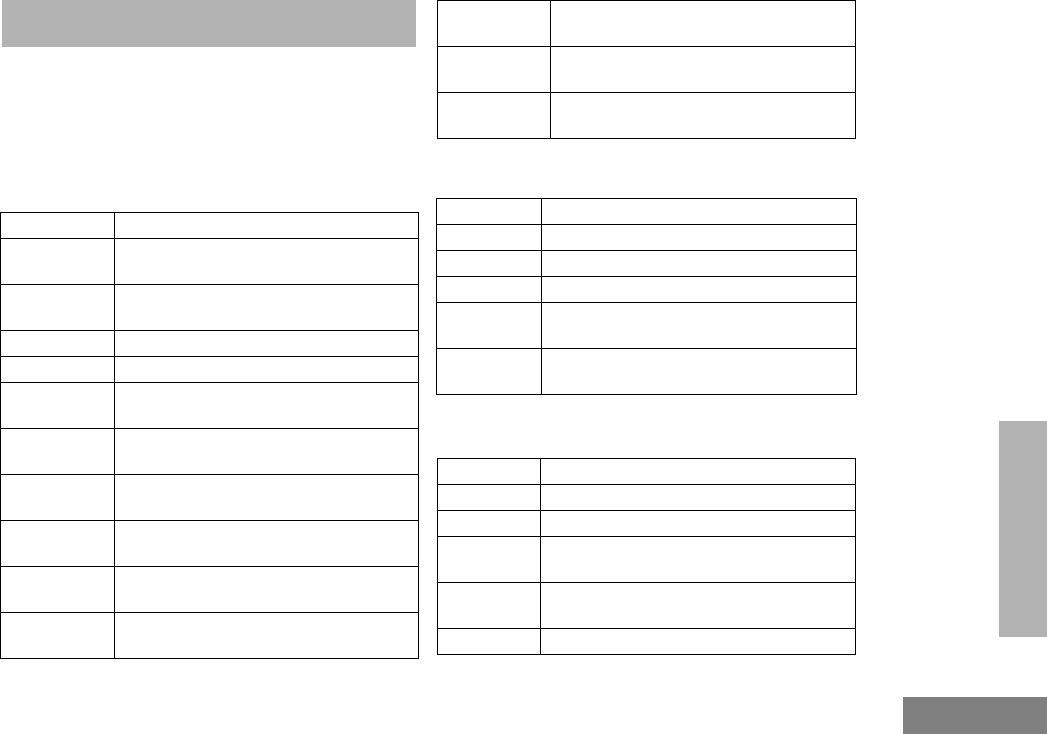
57
English
ACCESSORIES
ACCESSORIES
Motorola offers a number of accessories to
enhance the productivity of your two-way radio.
Many of the available accessories are listed
below.
ANTENNAS ALARM AND ACCESSORIES
AUDIO
HAD4006 VHF 136-144 MHz, 1/4 Wave Roof Mount
HAD4007 VHF 144-150.8 MHz, 1/4 Wave Roof
Mount
HAD4008 VHF 150.8-162 MHz, 1/4 Wave Roof
Mount
HAD4009 VHF 162-174 MHz, 1/4 Wave Roof Mount
RAD4000 VHF 136-174 MHz, 3 dB Gain (no mount)
HAD4014 VHF 140-174 MHz, 3.5 dB Gain Roof
Mount
HAE4002 UHF 403-430 MHz, 1/4 Wave Roof
Mount
HAE4003 UHF 450-470 MHz, 1/4 Wave Roof
Mount
HAE4004 UHF 470-512 MHz, 1/4 Wave Roof
Mount
HAE4010 UHF 406-420 MHz, 3.5 dB Gain Roof
Mount
HAE4011 UHF 450-470 MHz, 3.5 dB Gain Roof
Mount
RAE4004_RB UHF 445-470 MHz, 5 dB Gain Roof
Mount
RAE4004_MB UHF 445-470 MHz, 5 dB Gain Magnetic
Mount
TAE6053 UHF 430-450 MHz, 1/4 Wave Roof
Mount
RLN4856 Footswitch with Remote PTT
RLN4857 Pushbutton with Remote PTT
RLN4858 Gooseneck PTT
RLN4836 External PTT with Emergency Footswitch
HLN9328 External Alarm Relay (used in conjunction
with GLN7282)
GLN7282 Buzzer Kit (used in conjunction with
HLN9328)
HMN3596 Standard Microphone
HMN1035 Heavy Duty Microphone
RMN5029 Enhanced Keypad Microphone
RMN5018 Mag One Microphone (Low Cost)
(6 months warranty only)
RMN5019 Mag One Keypad Microphone (Low Cost)
(6 months warranty only)
AAREX4617 Telephone Style Handset Kit
09_Accessory.fm Page 57 Thursday, March 18, 2004 4:43 PM
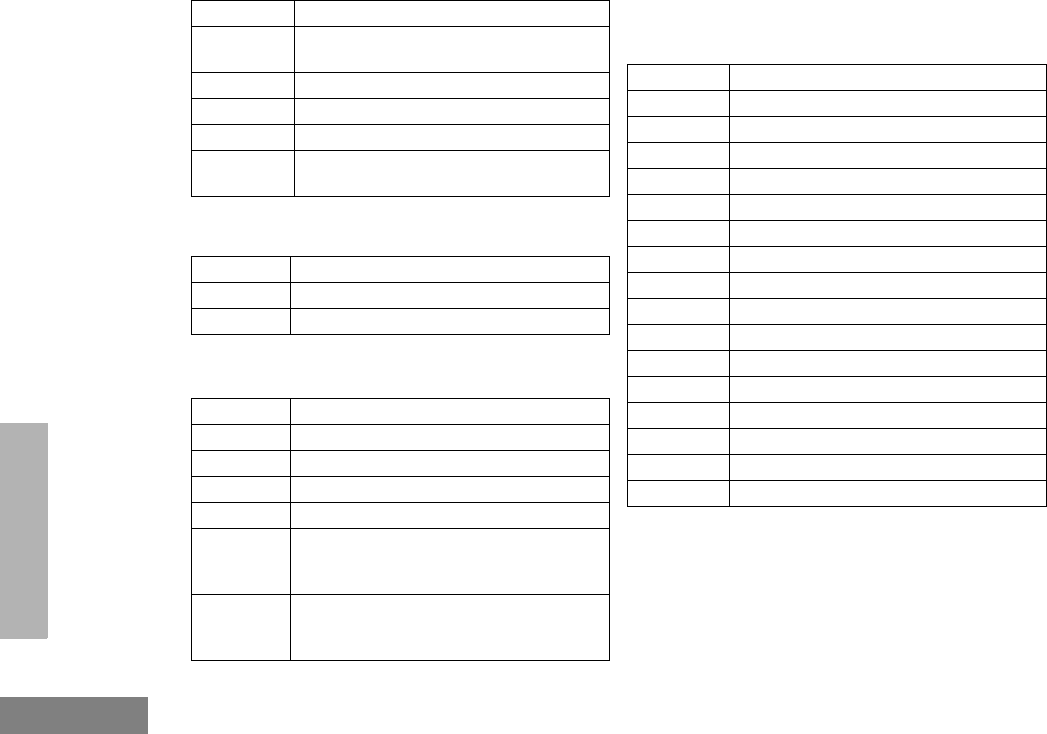
58
English
ACCESSORIES
CABLES
CONTROL STATION
DATA - CES WIRELESS
TECHNOLOGIES
GMMN4065 Visor Microphone (Omni-Direction)
AARMN4027 Visor Microphone - High Noise
(Uni-Direction)
RSN4001 External Speaker 13 W
HSN8145 External Speaker 7.5 W
HLN9073 Microphone Hang-up Clip (requires install)
HLN9414 Microphone Hang-up Clip (Universal - no
install required)
HKN9327 Ignition Switch Cable
HKN4137 Low Power Cable to Battery (1-25 W)
HKN4191 High Power Cable to Battery (25-60 W)
HPN4002 Desktop Power Supply 1-25 W
HPN4001 Desktop Power Supply 25-60 W
HMN3000 Black Desk Microphone
RLN5390 Desktop Tray with Speaker
RLN5391 Desktop Tray without Speaker
RLN5492 Low Power Control Station Kit (1-25 W)
(includes power supply, desktop tray, and
desk mic)
RLN5493 High Power Control Station Kit (25-60 W)
(includes power supply, desktop tray, and
desk mic)
RDN7364 Base Modem
RDN7367 Mobile Display Terminal with GPS
RDN7368 Mobile Display Terminal
RDN7369 Stand Alone Modem with GPS
RDN7370 Interface Cable, 3 ft
RDN7376 Interface Cable, 15 ft
RDN7372 Fixed Mount GPS Active Antenna
RDN7373 Mobile Printer
RDN7374 Programming Software for CES Equipment
RDN7380 Mobile Programming Hardware
RDN7375 Magnetic Mount GPS Antenna
RDN7377 MAPS (US) Regional
RDN7378 AVL Messaging Statue Software
RDN7371 Credit Card Reader
RDN7738 Serial Breakout Unit (multiple modems)
RDN7739 Flying Lead Cable, 3 ft.
RDN7740 Flying Lead Cable, 15 ft.
09_Accessory.fm Page 58 Thursday, March 18, 2004 4:43 PM
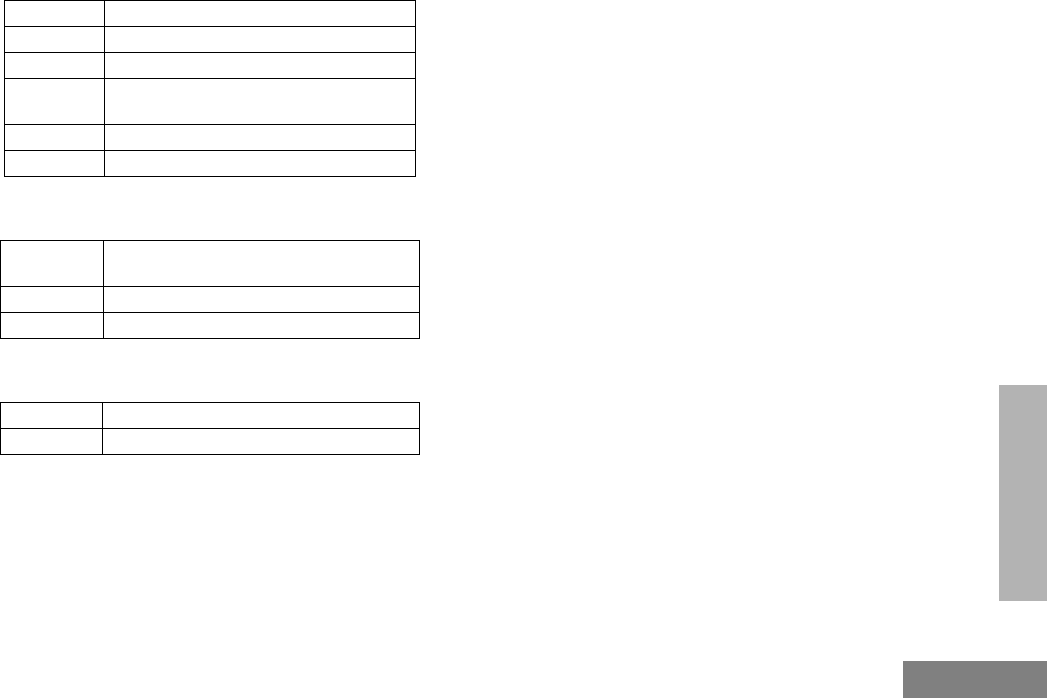
59
English
ACCESSORIES
MOUNTING
PUBLIC ADDRESS
PERIPHERALS
GLN7324 Low Profile Mounting Bracket
GLN7317 High Profile Mounting Bracket
FTN6083 DIN Mount
HLN8097 Removable Slide Mount with Mini-U
Connector
HLN9227 8 in. Gooseneck Trunnion
RLN4779 Keylock Mounting Bracket
RLN5288 Public Address Kit (includes switch box
and cabling)
HKN9324_R Speaker Cable for PA (15 ft)
HSN1000 External Speaker, 6 W for public address
HLN3948 Basic RICK (Repeater Interface Comm Kit)
HLN3333 RICK (Repeater Interface Comm Kit)
09_Accessory.fm Page 59 Thursday, March 18, 2004 4:43 PM

60
English
ACCESSORIES
Notes:
09_Accessory.fm Page 60 Thursday, March 18, 2004 4:43 PM
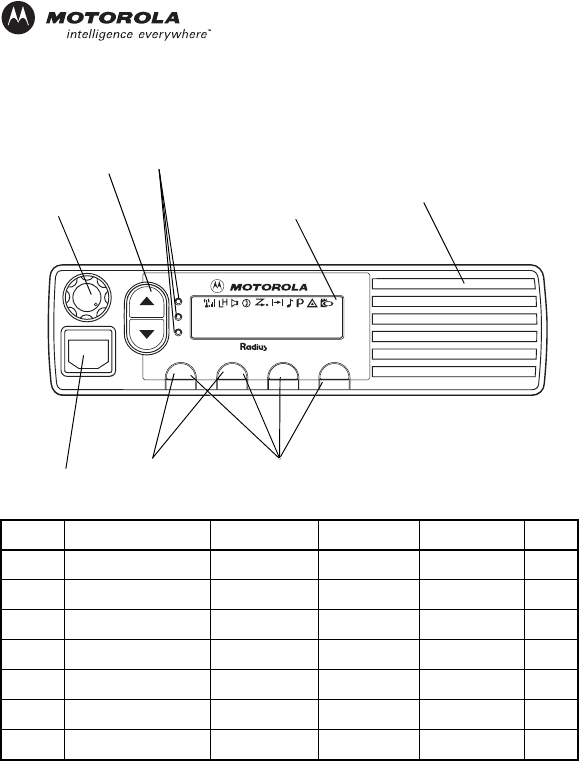
Turn the Radio On or Off
1. Rotate the On/Off/Volume Control knob clockwise. You will hear the self-
test pass tone and see the green LED indicator and display icons light
momentarily.
2. Rotate the On/Off/Volume Control knob counterclockwise until you hear a
click and both the display and the LED indicators turn off.
Adjust the Volume
1. Turn the On/Off/Volume Control knob clockwise to increase the volume,
or counterclockwise to decrease the volume.
Select a Radio Channel
1. G or H to select the desired channel.
Receive
1. Turn radio on and adjust volume to the desired level.
2. Select desired channel.
3. Listen for voice activity. The red LED indicator flashes while your radio is
receiving.
Transmit
1. Hold the microphone vertically 1 to 2 inches (2.5 to 5 cm) from your mouth.
Press the PTT button to talk. The red LED indicator lights steady while the
call is being sent.
2. Release PTT button to listen.
Start or Stop System Scan
1. Press the preprogrammed Scan button to start scan. – OR – G or H to
select a channel that contains a Scan list. From the Scan menu, select
SCAN ON. The green LED indictor blinks during scan operation.
2. Press the preprogramed Scan button again to stop scan. – OR – from the
Scan menu, select SCAN OFF.
Start or Stop Auto Scan
1. G or H to select a channel that has been preprogrammed for Auto Scan
by your dealer/programmer.
2. G or H to select a channel that has not been preprogrammed for Auto
Scan by your dealer/programmer.
Delete a Nuisance Channel During Scanning
1. While radio is on a nuisance channel, hold down preprogrammed Nui-
sance Delete button until you hear a tone.
2. Release Nuisance Delete button.
CM300™ Quick Reference Card
Record the functions for your radio’s programmable buttons in the table
provided below. For further information, see page 12 of this User Guide.
P2
P1 P3 P4
CM300
PERS4
Red/Yellow/Green
LED Indicators
Programmable
Buttons (P1, P2, P3, P4))
Microphone
Jack
Knob
On/Off/Volume Display
Channel Selector
Menu Scroll Buttons
Speaker
Menu Buttons
(P1, P2)
Button Function Short Press Long Press Hold Down Page
10_QR-Card.fm Page 61 Friday, July 11, 2003 11:34 AM
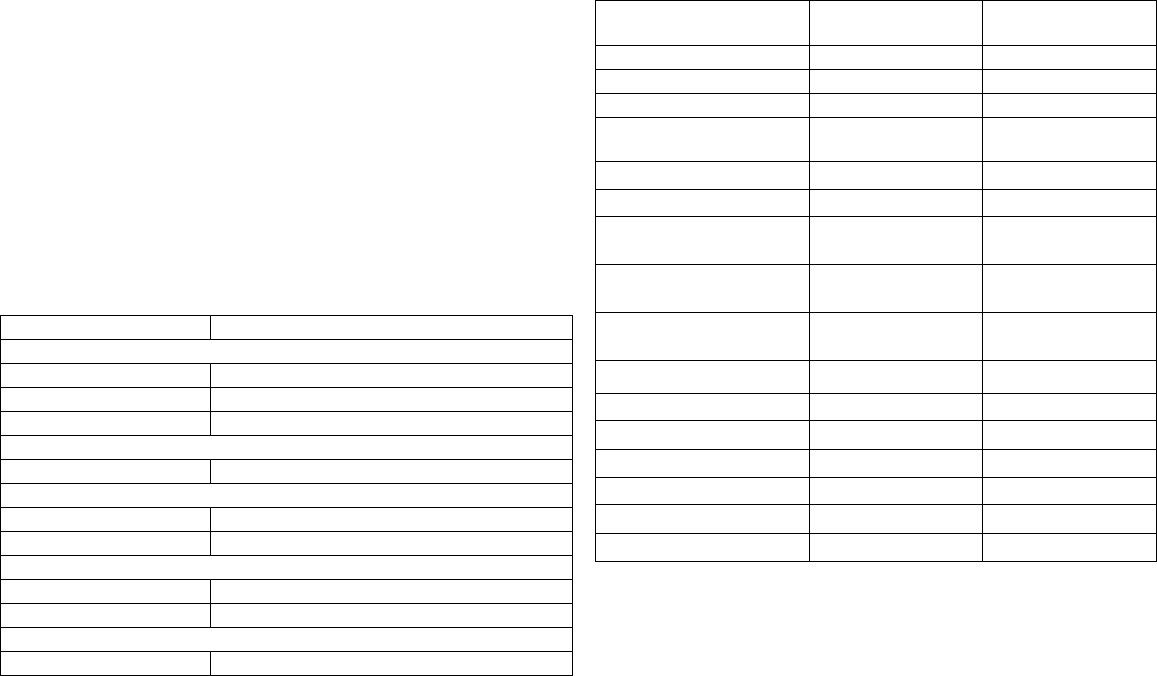
Restore Channels to the Scan List
Power off the radio then turn it on. – OR – Press the preprogrammed Scan button
to stop the scan. The Deleted Nuisance Channels are restored to the scan list.
– OR – G or H to select a channel that has not been preprogrammed by your
dealer/programmer to stop Scan. Once you return to the original channel, the
deleted nuisance channels are restored to the scan list.
Send a Selective Call
1. From the Selective Call menu, select or enter desired radio ID number.
2. Press PTT button to send the call.
3. Press and hold the PTT button to speak; release to listen.
Receive a Selective Call
1. When a Selective Call is received, the radio displays F and the name or ID of
the calling radio; the yellow LED flashes and two tones are heard.
2. Press PTT button to acknowledge the call.
3. Press and hold the PTT button to speak; release to listen.
LED Indicators
Audio Indicators for Programmable Buttons
LED State/Color Indication
Radio Call
Red Transmitting
Flashing Red Receiving
Flashing Red Channel Busy
Scan
Flashing Green Scanning for activity
Call Alert
Flashing Yellow Indicates receiving a Call Alert
Yellow Indicates sending a Call Alert
Selective Call
Flashing Yellow Indicates receiving a Selective Call
Yellow Indicates sending a Selective Call
Sticky Monitor/Open Squelch
Yellow While monitoring
Programmable Buttons Positive
Indicator Tone Negative
Indicator Tone
Scan Start Stop
Power Level High Low
Squelch Tight Normal
Repeater/Talkaround Does not use
repeater Uses repeater
VOX Enabled Disabled
Local/Distance Local Distance
Sticky Monitor/Open
Squelch
–Enabled
Home Revert Memory
Channel (1&2)
–Enabled
Story Memory Channel
(1&2)
–Stored
Menu Mode D–Accessed
Radio Call – Enabled
Scan List Edit – Enabled
Speed Dial – Enabled
Phone Mode – Enabled
Option Board Enabled Disabled
Escalert Enabled Disabled
10_QR-Card.fm Page 62 Friday, July 11, 2003 11:34 AM
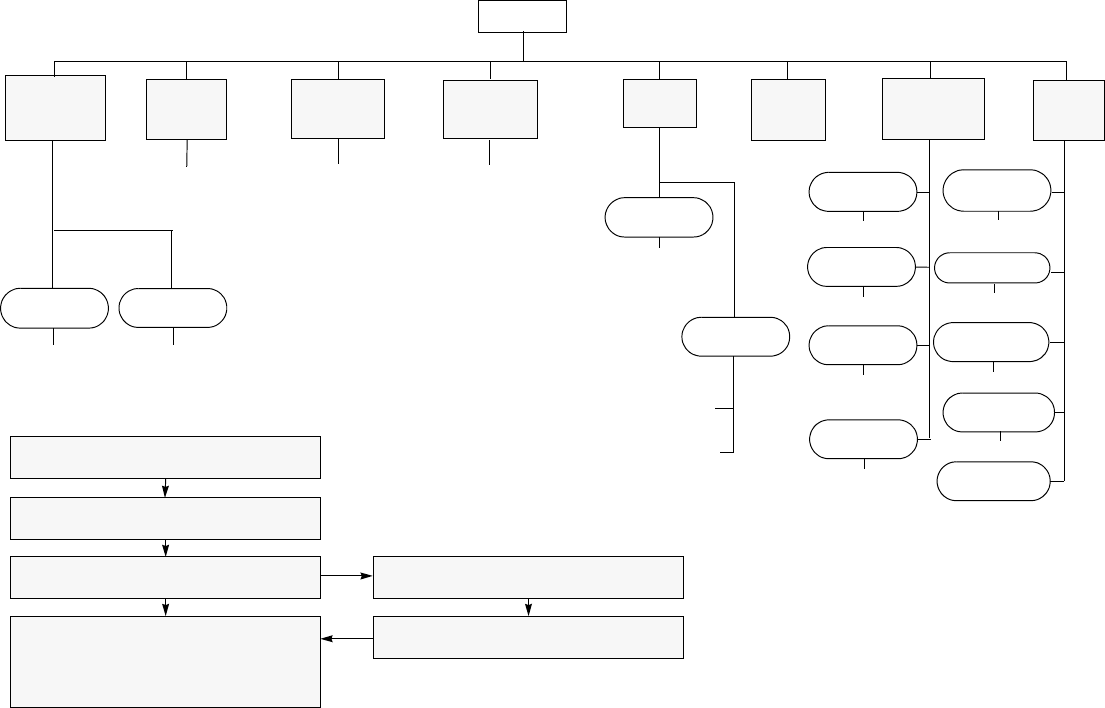
priority
Menu Navigation
D
on/off
Scan List
(p. 29)
Phone List
(p. 36)
add/delete
entry
Selective
Call Call Alert
Alert
Keypad
Escalert
add/delete/
edit/edit code
entry
on/off
select/enter
ID
GH
GHGH
GH
select/enter
ID
repeater mode/
talkarnd mode
GHGHGH
on/off
on/off
standard/alert
#1 - #6
Tone Tag
Squelch
normal/
tight
Power Level
high/low
Option
Board
Backlight
Intensity
high/med/low
D to enter menu mode
G or H to scroll through the list
D to select menu item
C to return to previous menu level
—or—
Hold down C to exit menu mode
G or H to scroll through sub-list
D to select sub-menu item
Phone
(p. 33)
Program
Lists
System
Scan
(p. 27)
Utility
(p. 47)
Rptr/
Talkarnd
(p. 19)
Menu Navigation Chart
(Refer to Menu Navigation guidelines—
lower, left-hand corner of this page)
Software
Ver#
on/off
Radio Call Tones
(p. 41)
GH
Edit PL/
DPL Codes
(p. 21)
Rx/Tx
menu_nav.fm Page 105 Thursday, July 24, 2003 4:25 PM

CM300™
Commercial Series
Two-Way Radio User Guide
Manuel de l'utilisateur
de la radio bidirectionnelle
MOTOROLA, the Stylized M Logo, and Radius are registered in the US Patent & Trademark Office.
All other product or service names are the property of their respective owners.
© Motorola, Inc. 2003. All rights reserved. Printed in U.S.A.
MOTOROLA, le logotype au M stylisé et Radius sont enregistrés auprès du Bureau des marques et brevets des États-Unis.
Tous les autres noms de produits et de services sont la propriété de leurs titulaires respectifs.
© Motorola, Inc. 2003. Tous droits réservés. Imprimé aux États-Unis.
*6881096C22*
6881096C22-O
96C22-O_cvr.qxd 7/2/2003 11:04 AM Page 1